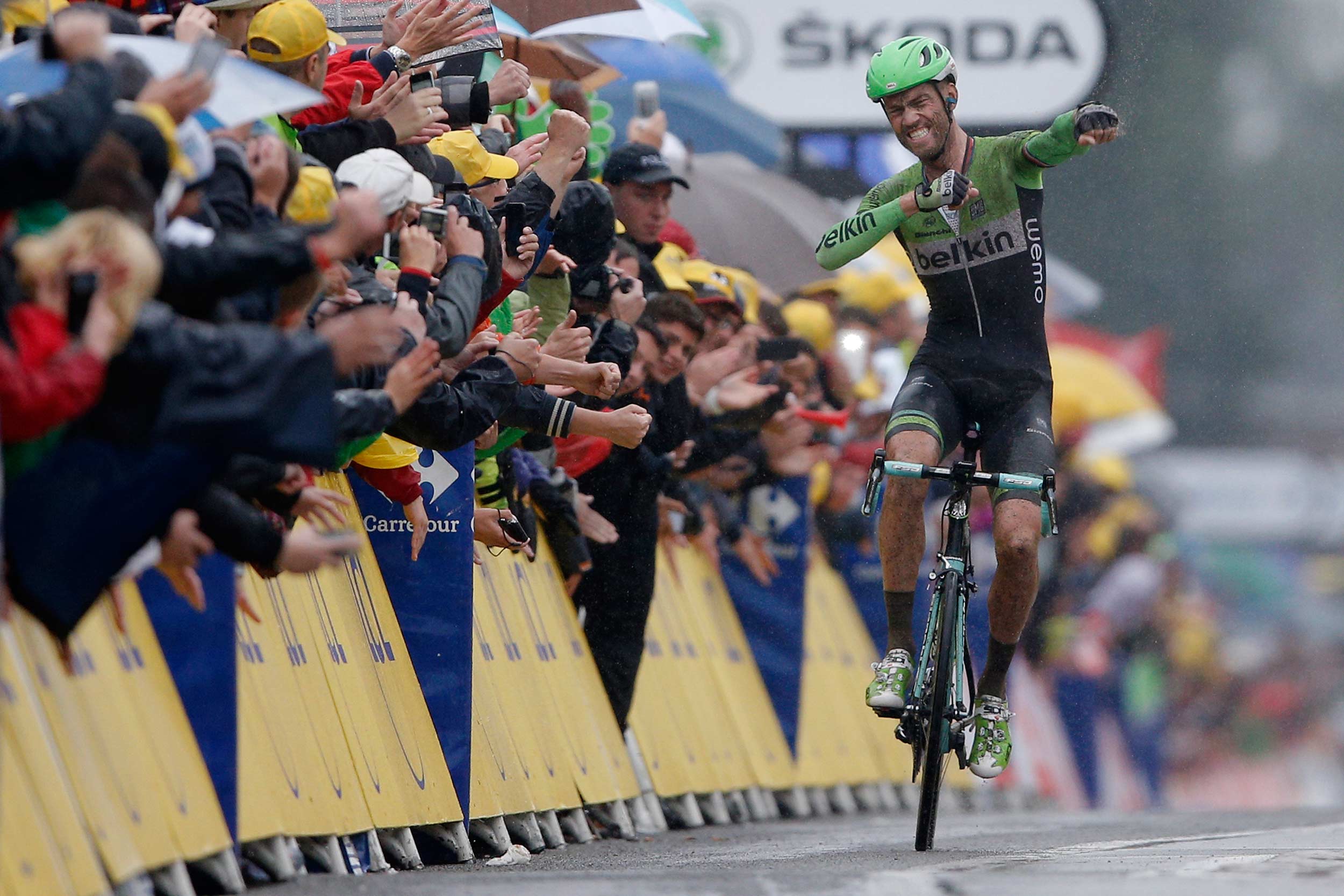
From New York to Wisconsin to London and beyond, the Ringling Bros. and Barnum & Bailey Circus has performed for millions of fans during its 146-year reign as one of the world's biggest big tops.
The show, which is closing down permanently because of declining ticket sales, has its roots in a spectacle that began two decades before the U.S. Civil War — equal parts freak show, zoo and museum. In 1881 it officially became the circus that generations grew up watching and saw many evolutions over the years, most recently with its decision to retire its elephant acts.
— 1841 — Phineas Taylor Barnum buys Scudder's American Museum in New York City and renames it Barnum's American Museum, which was something of a zoo, museum, lecture hall and freak show. It was filled with artifacts and items from around the world. The museum later burned down. Barnum also took his show on the road as "P.T. Barnum's Grand Traveling American Museum."
— 1881 — Barnum partners with James A. Bailey and James L. Hutchinson for "P.T. Barnum's Greatest Show On Earth, And The Great London Circus, Sanger's Royal British Menagerie and The Grand International Allied Shows United," later shortened to the "Barnum & London Circus."
— 1882 —The Ringling Brothers — Alf, Al, Charles, John and Otto — performed their first vaudeville-style show in Mazomanie, Wisconsin.
— 1884 — The Ringling Brothers Circus begins as a traveling performance.
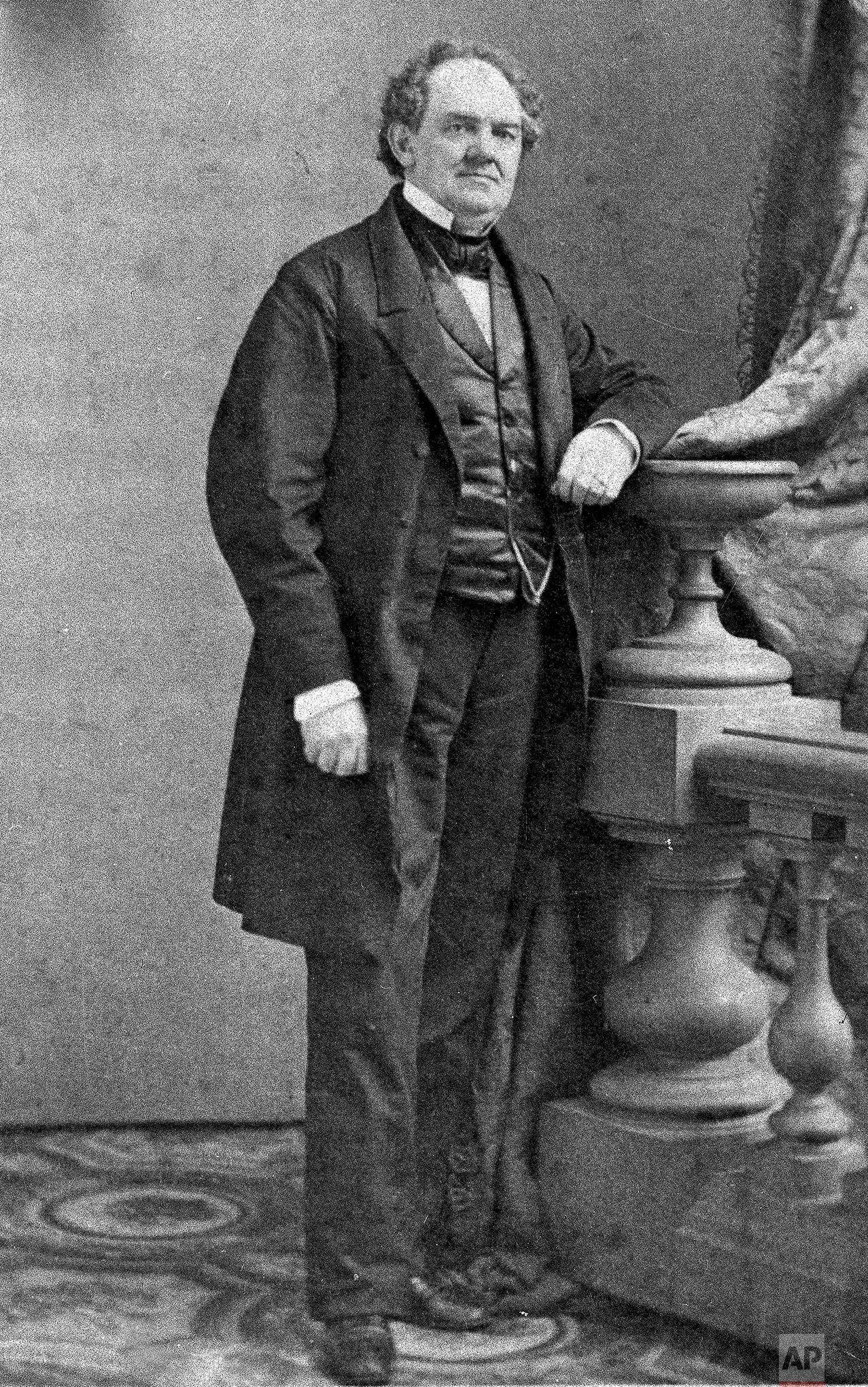
American showman P.T. Barnum is shown in 1882 in an unknown location. (AP Photo)
— 1887 — The official Ringling touring show became the "Ringling Bros. United Monster Shows, Great Double Circus, Royal European Menagerie, Museum, Caravan, and Congress of Trained Animals."
— 1895 — The Ringlings decided to branch out to New England, which was already the territory of P.T. Barnum. According to the Wisconsin Historical Society, the two circuses "agreed to divide the U.S. rather than compete head-to-head. The Ringlings established their headquarters in Chicago while Barnum and Bailey stayed in New York."
— 1907 — After the death of James Bailey, the Ringlings buy Barnum and Bailey. They keep the circuses separate, and the Wisconsin Historical Society wrote that by the 1910s the Ringling Bros. Circus had more than 1,000 employees, 335 horses, 26 elephants, 16 camels and other assorted animals that traveled on 92 railcars. The Barnum and Bailey Circus was roughly the same size.
— 1919 — The two circuses merged and became known as "Ringling Bros. and Barnum & Bailey Combined Shows."
— 1927 — John Ringling moves circus headquarters to Sarasota, Florida.
— 1967 — Irvin Feld, a music and entertainment promoter, buys The Ringling circus and formally acquires it in a ceremony held at the Colosseum in Rome.
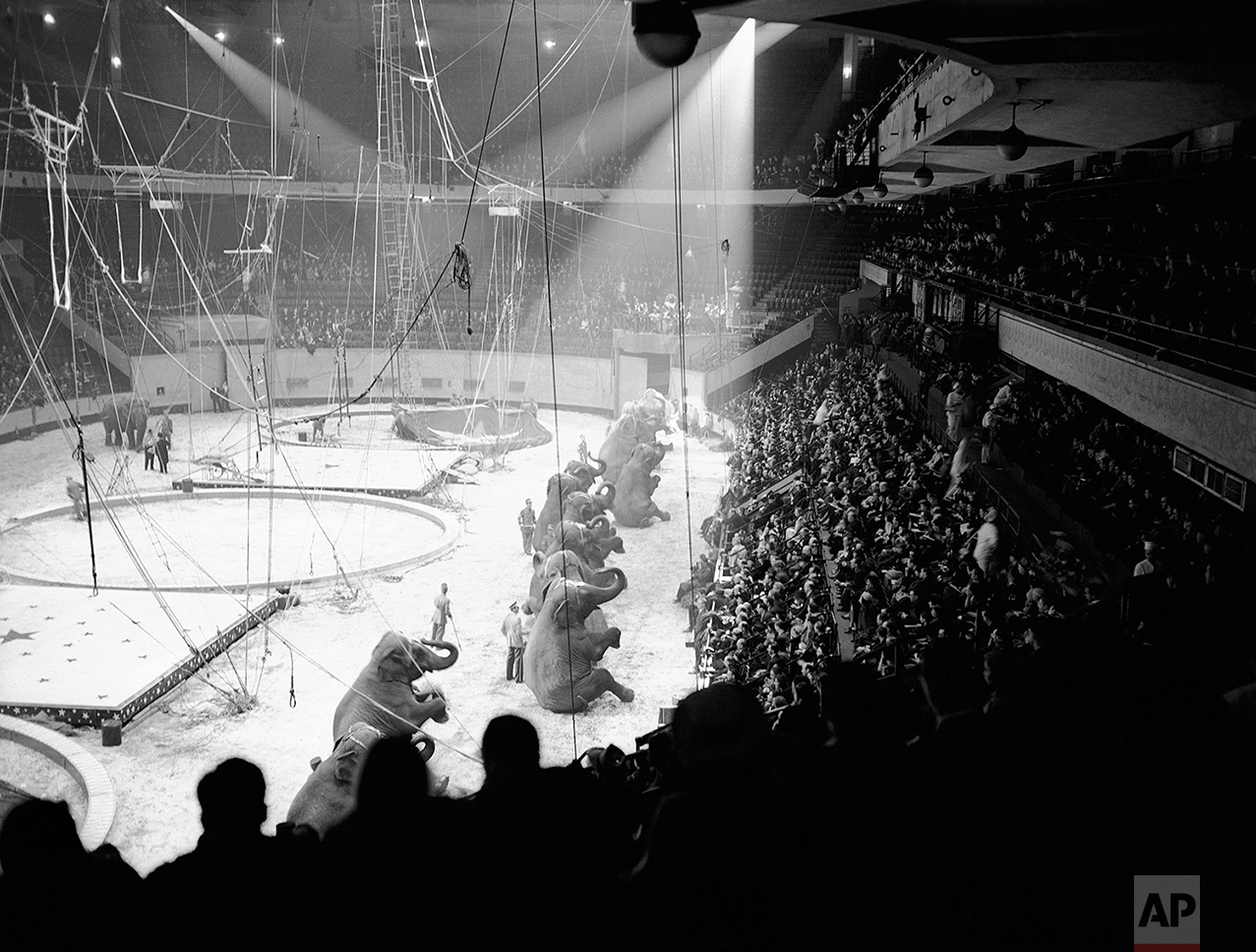
Greatest Show on Earth 1939
Opening night performance of the "Greatest Show on Earth" in New York's Madison Square Garden on April 5, 1939. The patrons witnessed the elephant troupe going through their regular paces as the Ringling Brothers Barnum and Bailey Circus opened its 1939 season. (AP Photo)
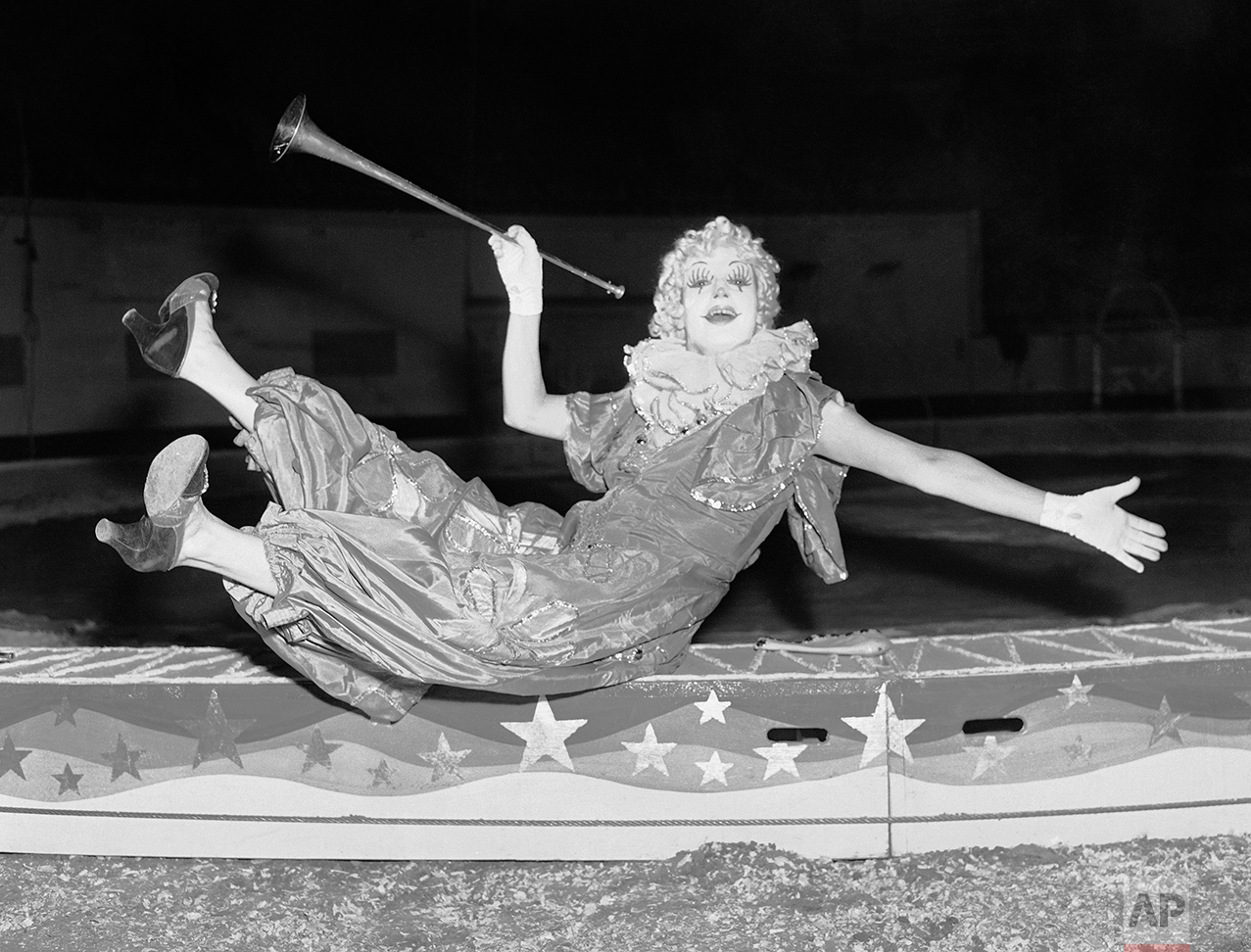
Lulu Albertino Female Clown 1939
Lulu Albertino, who claims to be the only woman clown in an American circus, makes her debut with the Ringling Brothers and Barnum & Bailey Circus at Madison Square Garden in New York, April 5, 1939. Lulu says "clowning is an up and down existence," and it's the "downs" such as this which get the biggest laughs. (AP Photo/Tom Sande)
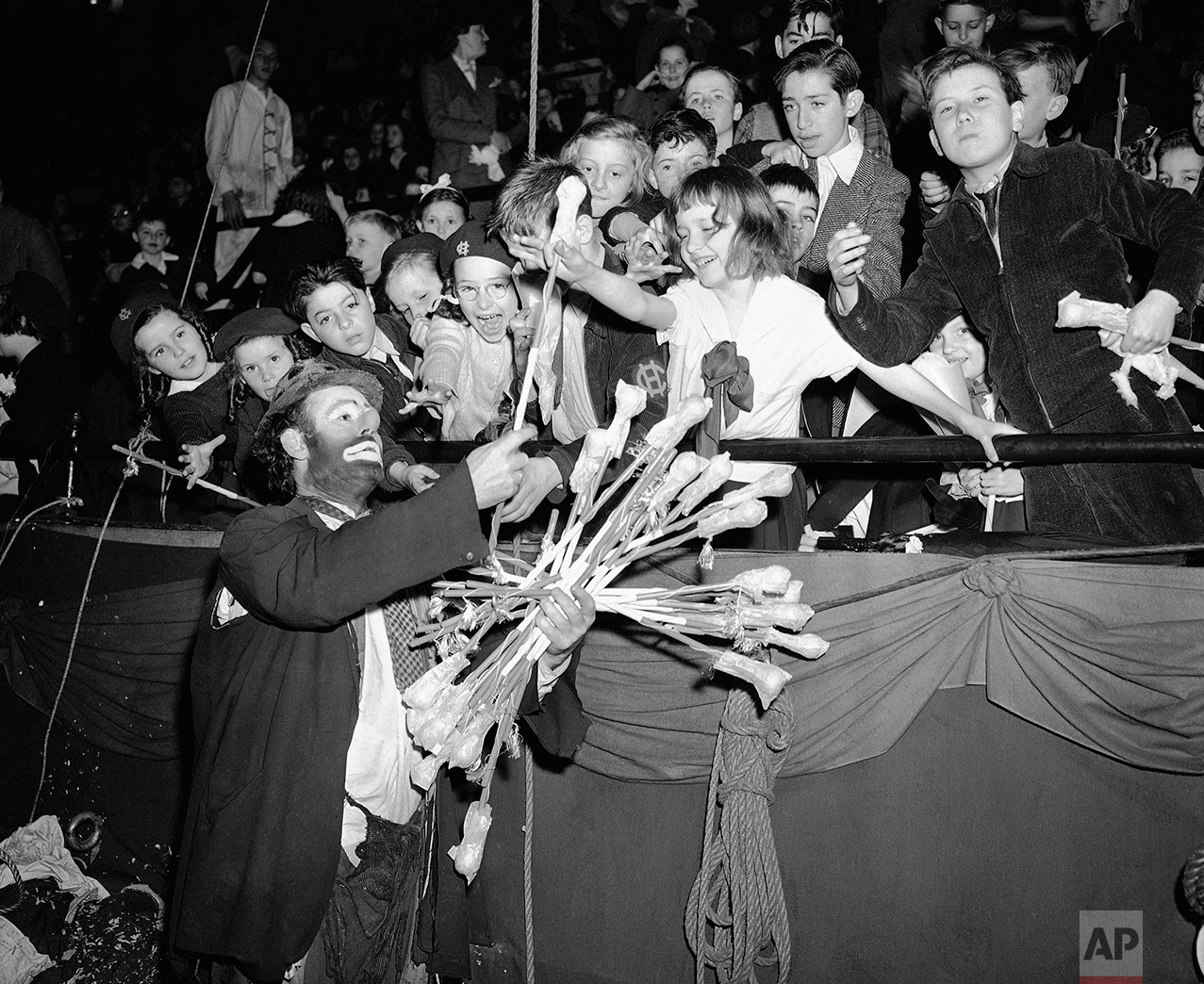
Emmett Kelly 1943
Emmett Kelly, famous clown, hands out canes to impatient youngsters at the special circus show in Madison Square Garden in New York on May 10, 1943 for crippled, orphaned, and underprivileged children. (AP Photo)
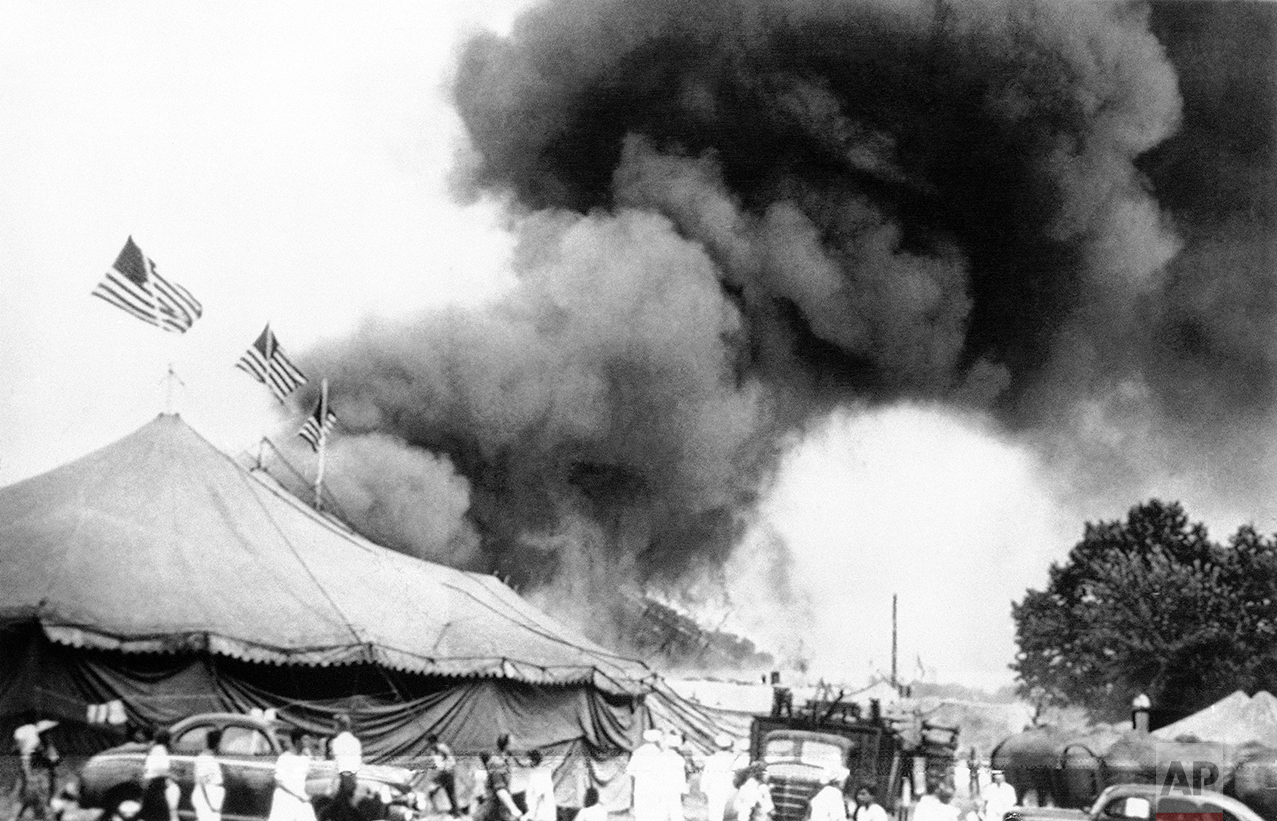
Circus Fire 1944
Flames shoot from the top of the main tent of the Ringling Bros. and Barnum and Bailey Circus during performance at Hartford, Connecticut on July 6, 1944. Shortly after, the tent collapsed, trapping many of the patrons who were still in the arena. (AP Photo)

Madison Square Garden Dress Rehearsal 1944
One of the Ringling Bros. and Barnum and Bailey Circus acts to go through its paces at a dress rehearsal in Madison Square Garden in New York, April 4, 1944 was the Loyal-Repensky troupe of riding performers whose members are grouped on two cantering white houses. The Big Show opens on April 5. (AP Photo/Anthony Camerano)
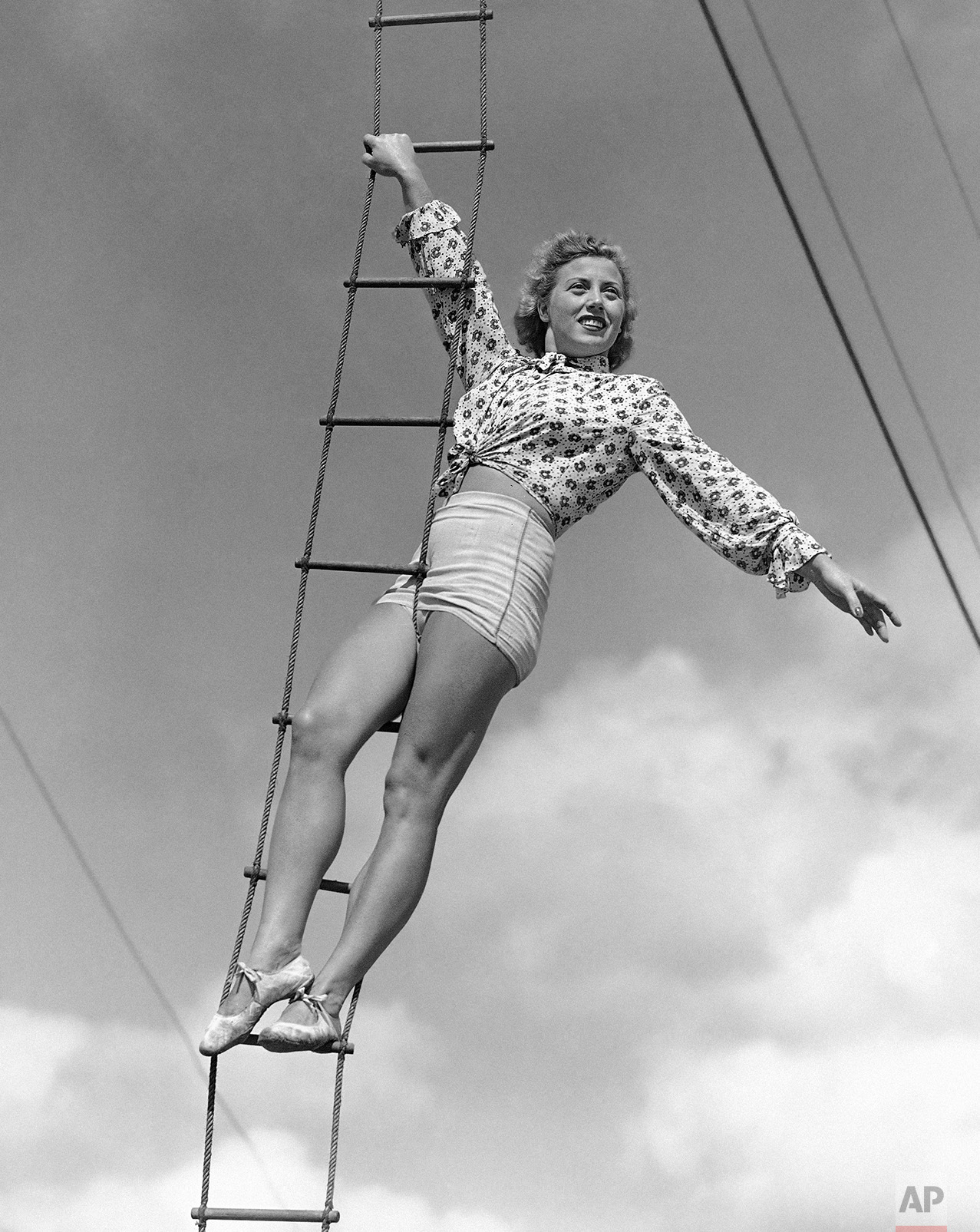
Flying Wallendas 1945
Elizabeth Wallenda pauses on an aerial ladder during rehearsal for her return to the Wallenda troupe's high wire act with the Ringling Brothers and Barnum and Bailey Circus, now in winter quarters in Sarasota, Fla., Feb. 28, 1945. Her former husband, Herman Wallenda, is a member of the troupe. (AP Photo/Earl Shugars)
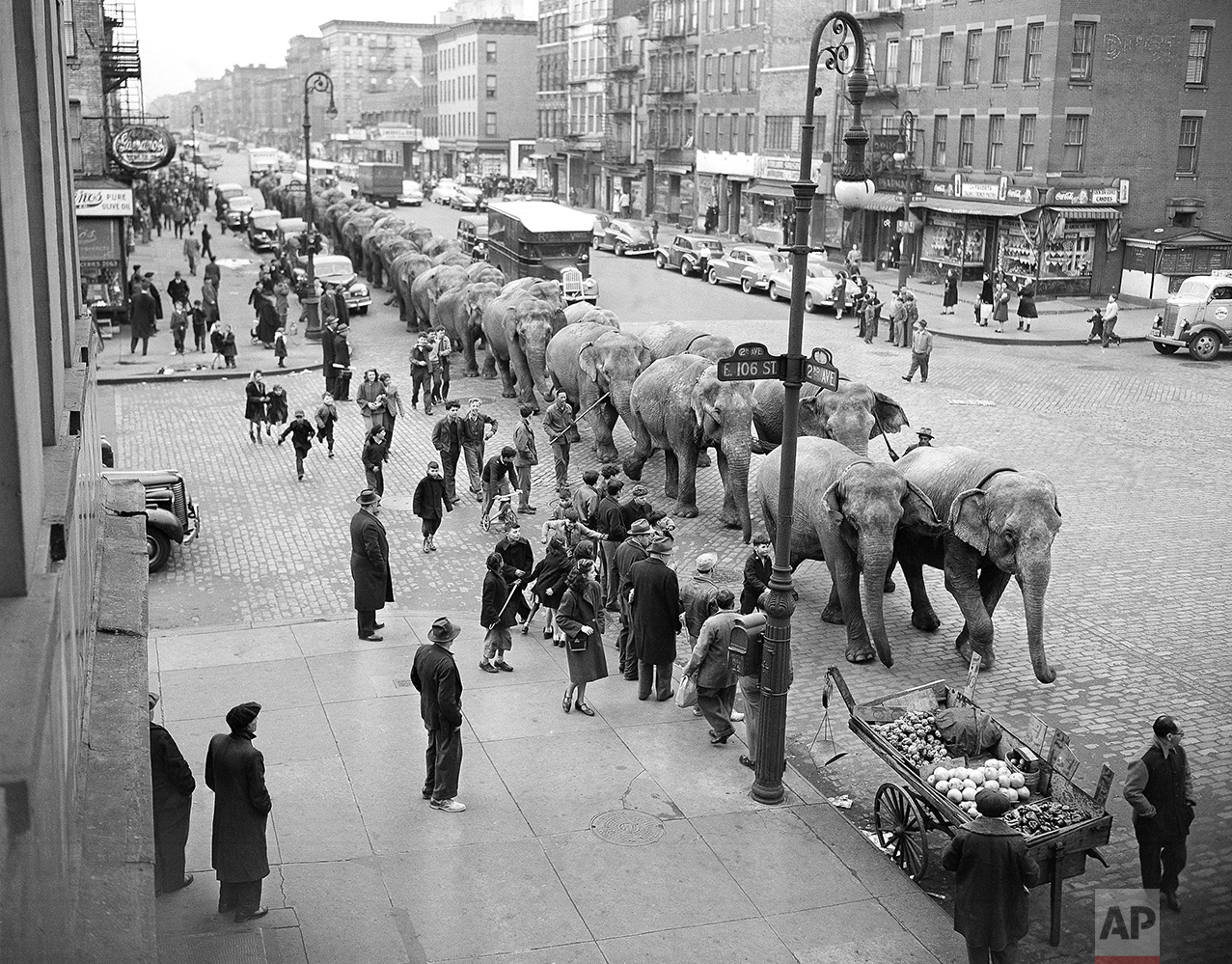
Circus Elephants On Parade 1948
Elephants from the Ringling Brothers and Barnum and Bailey Circus plod along Second Avenue at 106th Street in New York, April 2, 1948, after arriving by train for their annual appearance at Madison Square Garden. New York youngsters and some oldsters watch the pachyderms but the two lead elephants appear more than a little interested in the fruit stand in right foreground. (AP Photo/Harry Harris)
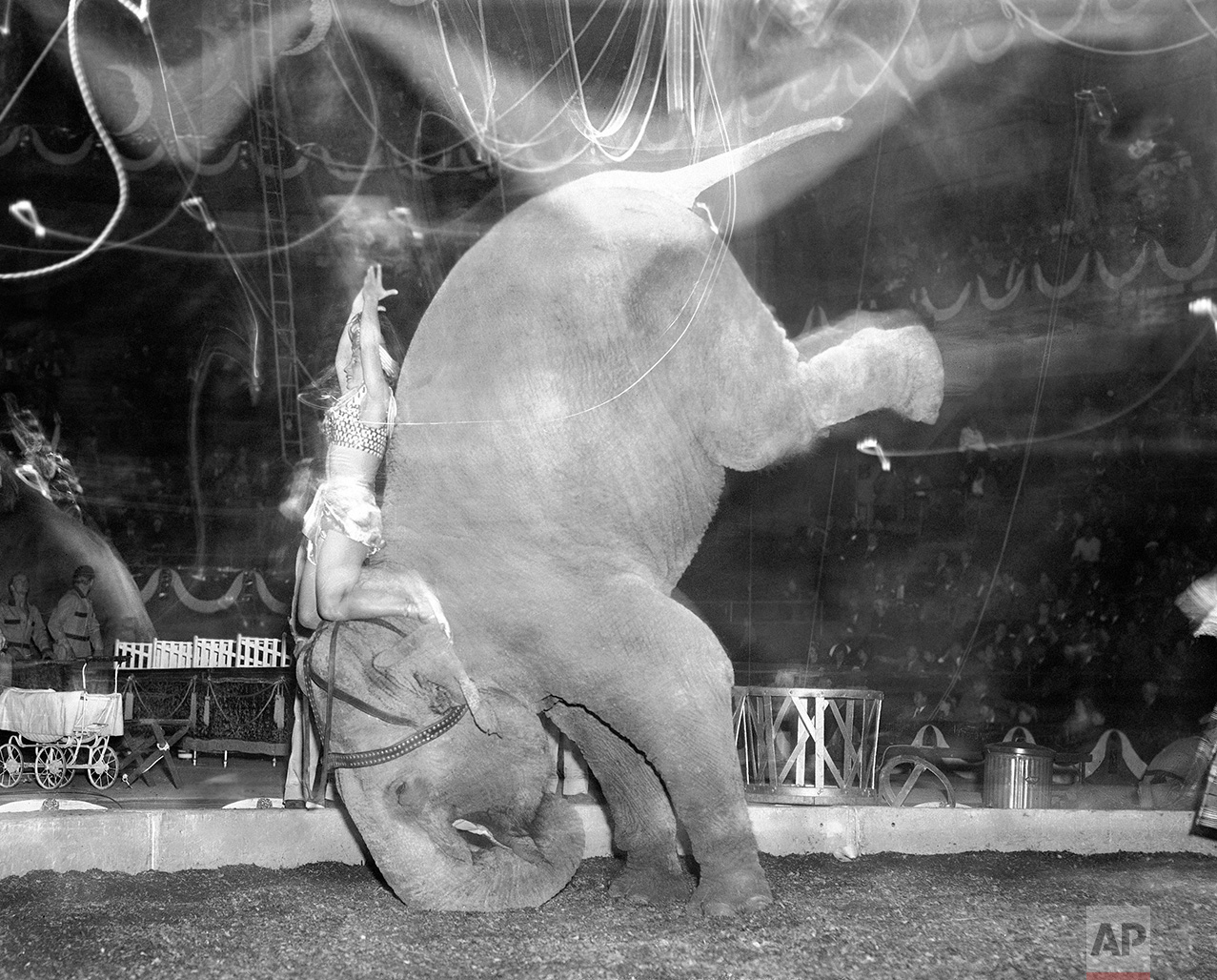
Elephant Performance 1949
“Skee Otaris’ hands are over her head as her pachyderm does a headstand during performance of Ringling Brothers and Barnum and Bailey Circus in Madison Square Garden in New York on April 9, 1949. (AP Photo/Matty Zimmerman)
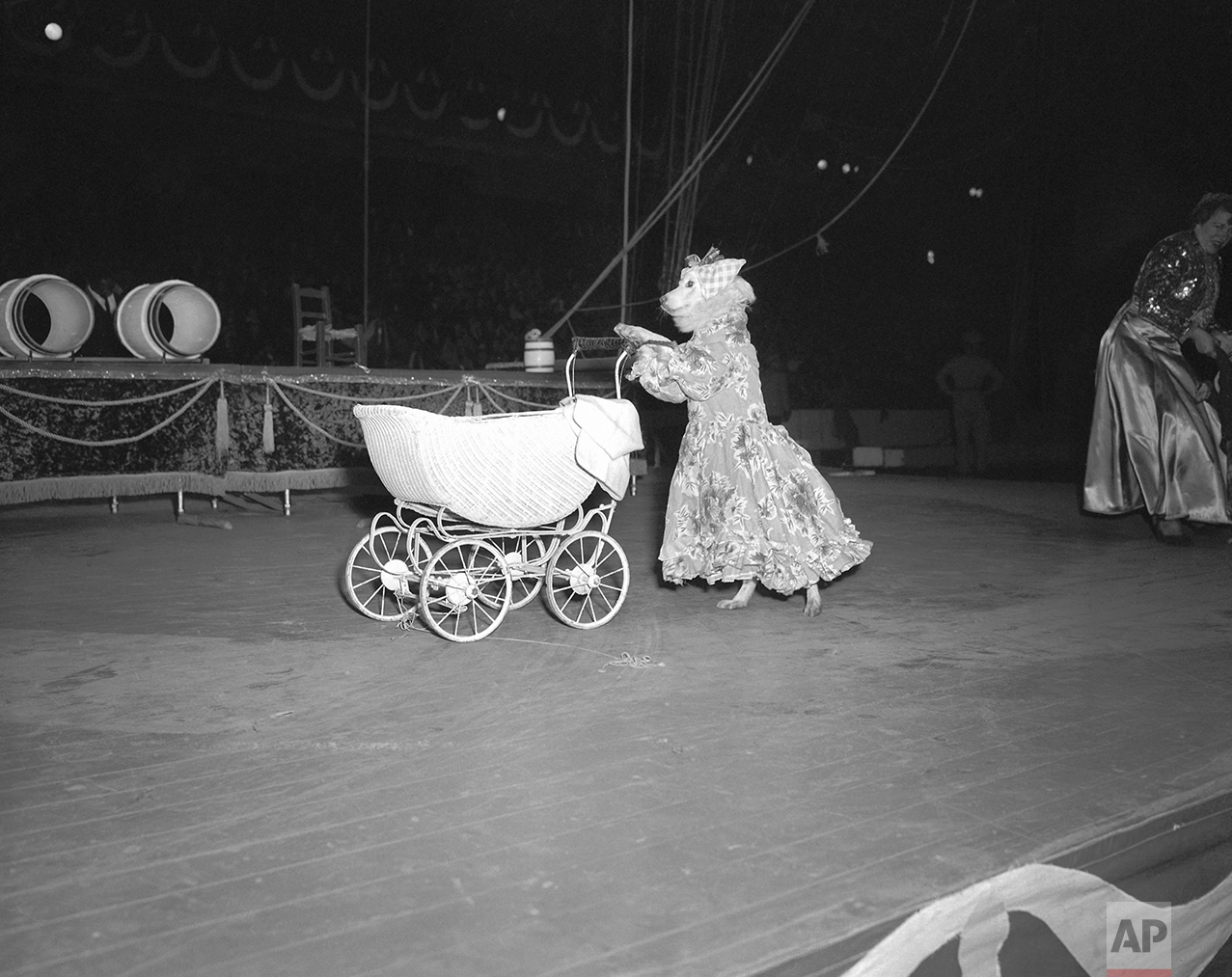
Canine Performer 1949
This dressed-up pooch goes through its routine at rehearsal in New York on April 6, 1949, (AP Photo/Ed Ford)
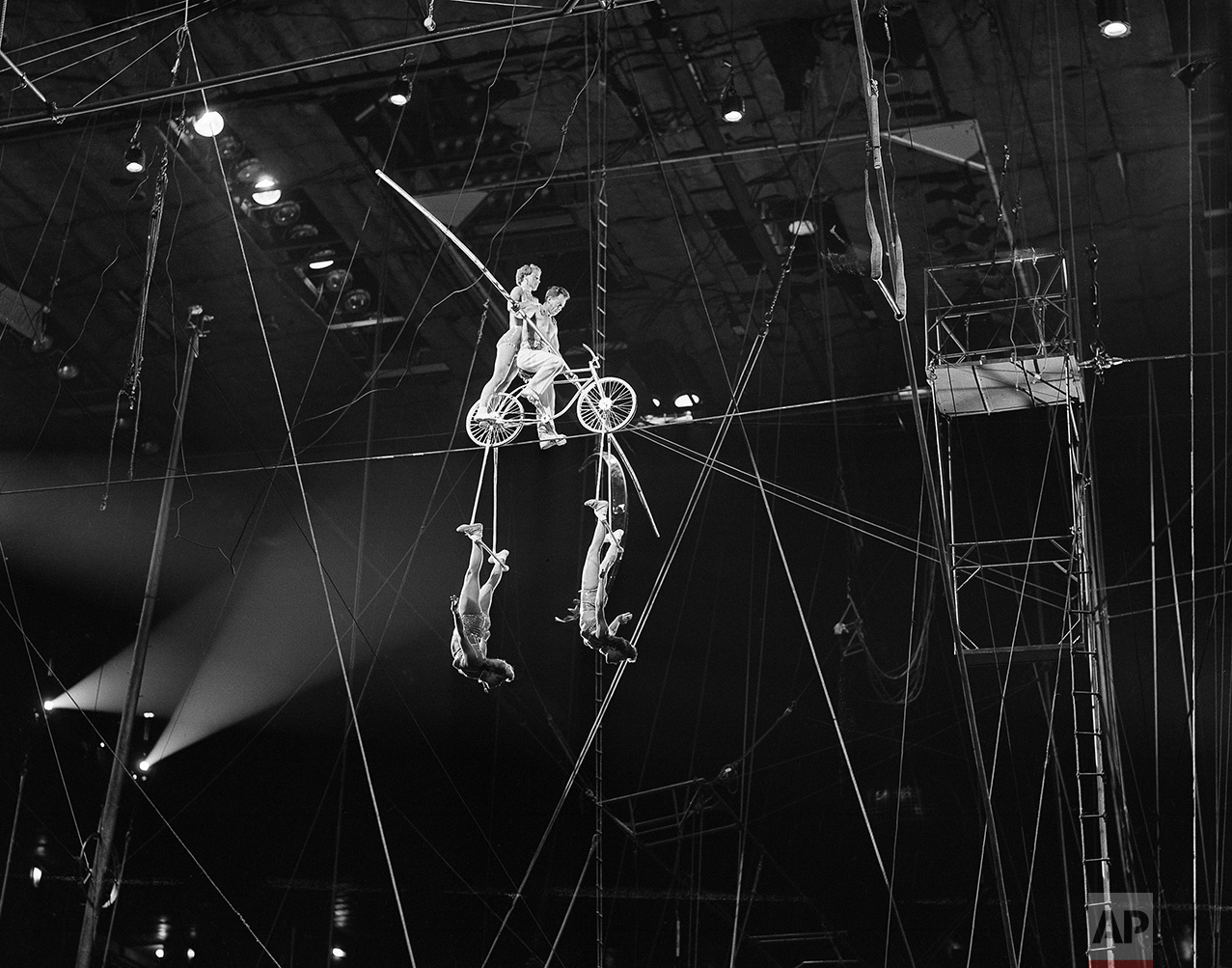
Circus High Wire Bike 1951
Harold Alzanas on the bicycle during the high wire Alzanas act of the big show now attracting kids of all ages at Madison Square Garden, New York, April 12, 1951. (AP Photo/Ed Ford)
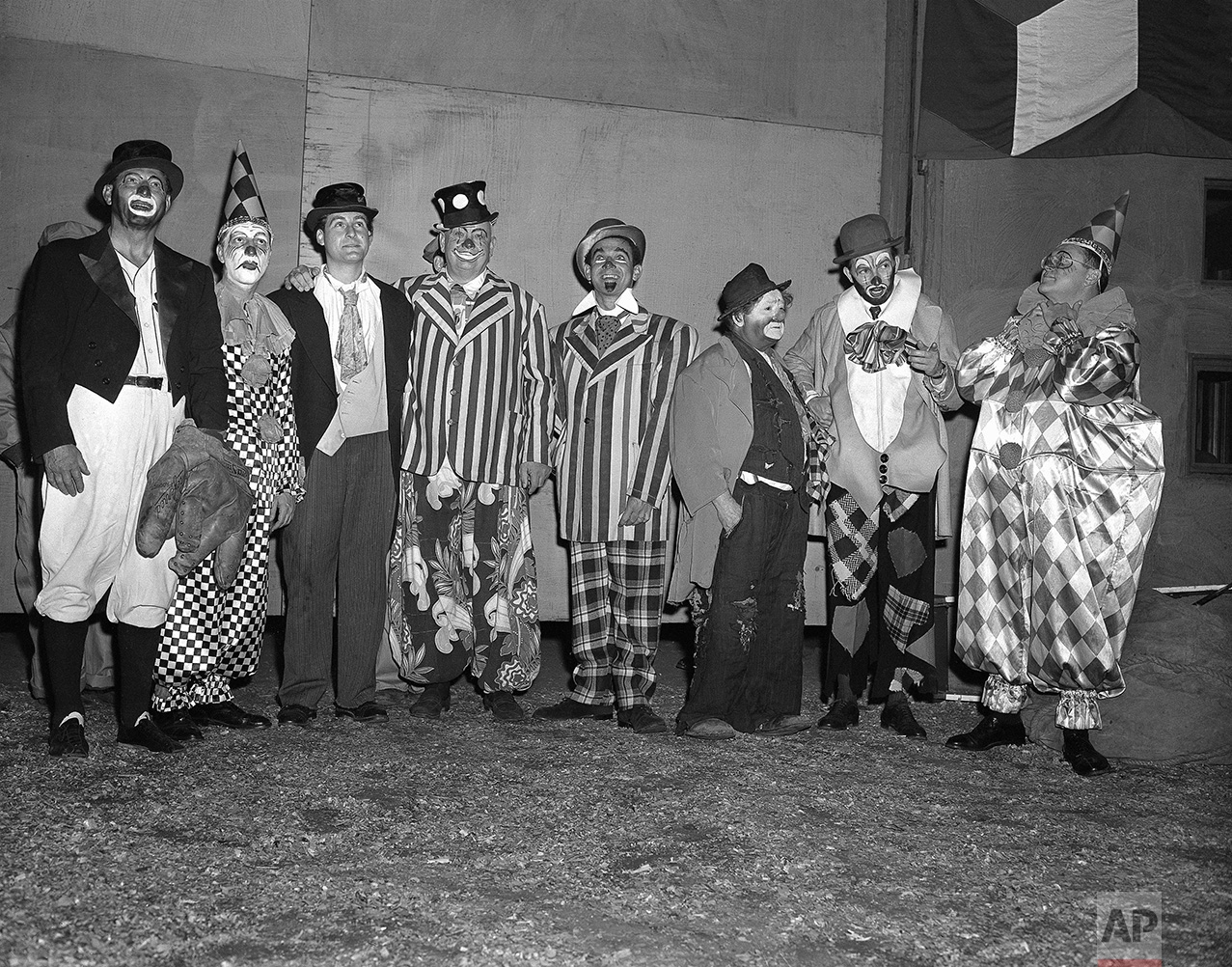
Circus Clowns 1953
Seven of these eight costumed clowns are radio and television personalities, while the eighth (third from right) is Otto Griebling, who earns his livelihood as a clown with Ringling Brothers and Barnum and Bailey Circus. Group gathered at New York's Madison Square Garden, April 1, 1953 for opening performance of "The Greatest Show On Earth." From left are: Al Schacht, perennial baseball clown; Garry Moore, Sid Caesar, Lauritz Melchior, Jack Carter, Otto Griebling, Herb Shriner and Sam Levenson. The radio and TV personalities participated in the opening night performance with proceeds going to United Cerebral Palsy of New York. (AP Photo/Matty Zimmerman)

Milton Berle 1955
Actor Milton Berle, shown as master of ceremonies on March 30, 1955 at Madison Square Garden. (AP Photo)

High Wire 1955
Sixty feet above the circus floor, Josephine Berosini goes through a series of stunts on a wire in New York on May 27, 1955. Josephine is billed by Ringling Brothers and Barnum & Bailey as "Queen of the High Wire." Now 29, she crossed a wire high in a circus tent for the first time when she was five. (AP Photo/Bob Wands)
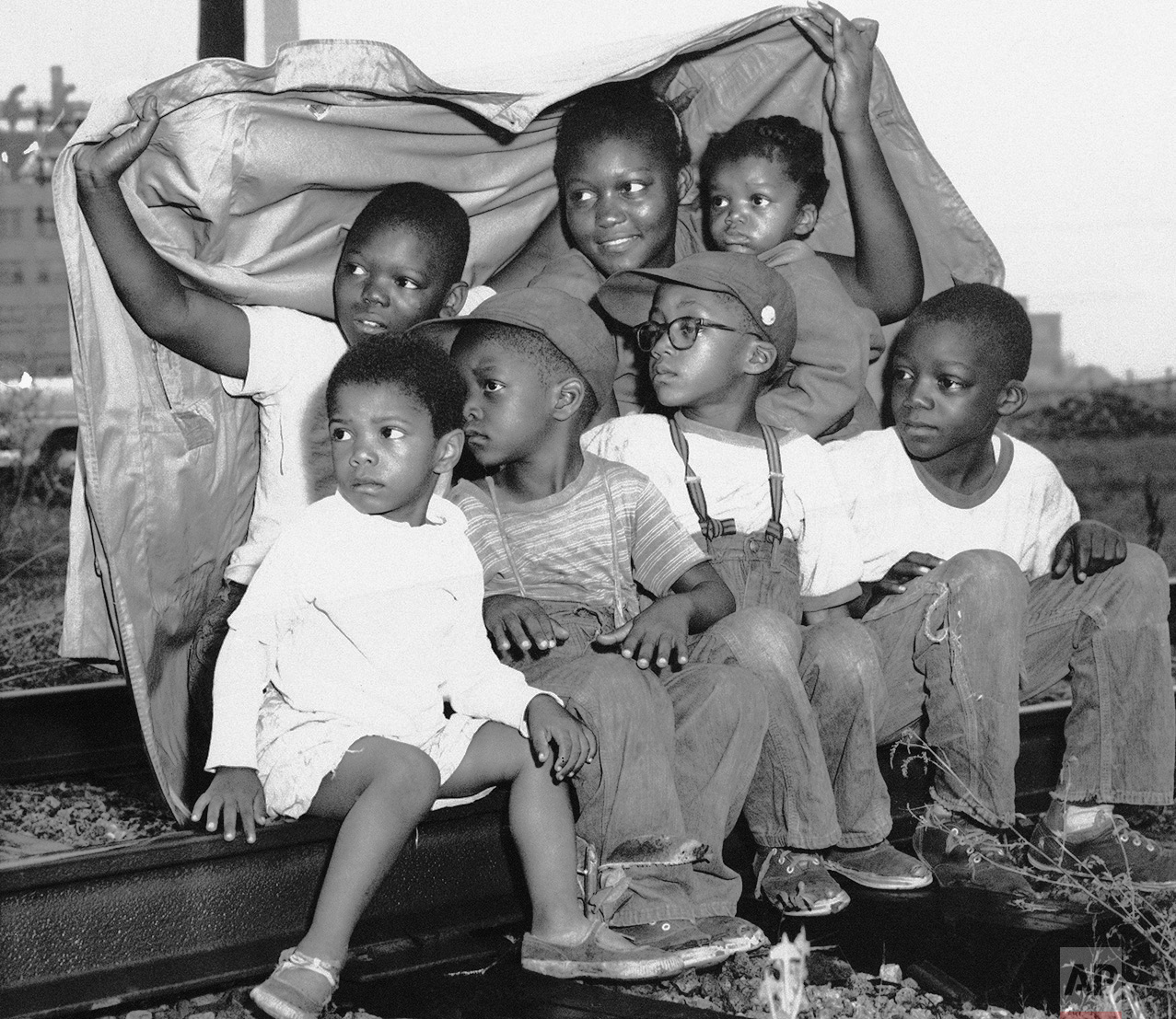
Waiting For The Circus 1956
Ringling Bros. Barnum and Bailey Circus was eight hours late arriving in Akron, though these seven youngsters rose to watch for the train, July 13, 1956. The children of Mr. and Mrs. Robert Davis, 1363 Hart St., are, front (from left), Marvin, 2; Ralph, 4; Allen, 6; Bobby, 8. In back, (from left) are Robert, Jr.,14;and Ruby Lee, 15, who is holding Eugela, 1. Mr. Davis is a former circus cook house employee. The circus train was late because one car was derailed near Youngstown, tearing up a section of track. The matinee here was canceled. (AP Photo)
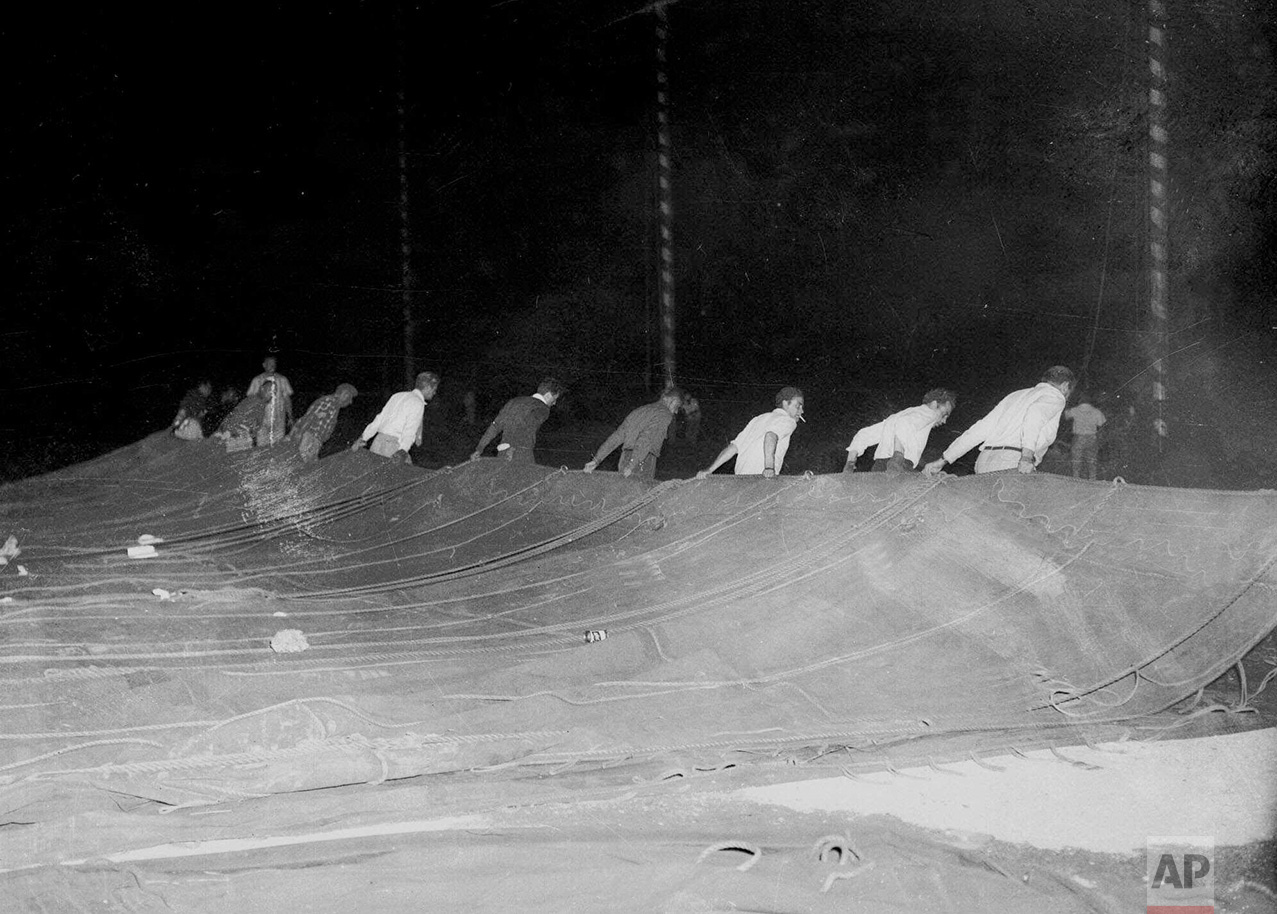
Big Top 1956
Workmen pull away the "big top" of the Ringling Bros. and Barnum & Bailey Circus in Pittsburgh, Pa., July 17, 1956. (AP Photo)

Unemployed Circus Performers 1956
Roy Smith, left, and Harry Burman, right, two dwarves from London, formerly with Ringling Bros., Barnum and Bailey Circus, get set for a long trip, maybe not to London, but somewhere for a job. They arrived aboard the train returning to circus winter quarters in Sarasota, Fla., July 20, 1956. (AP Photo)
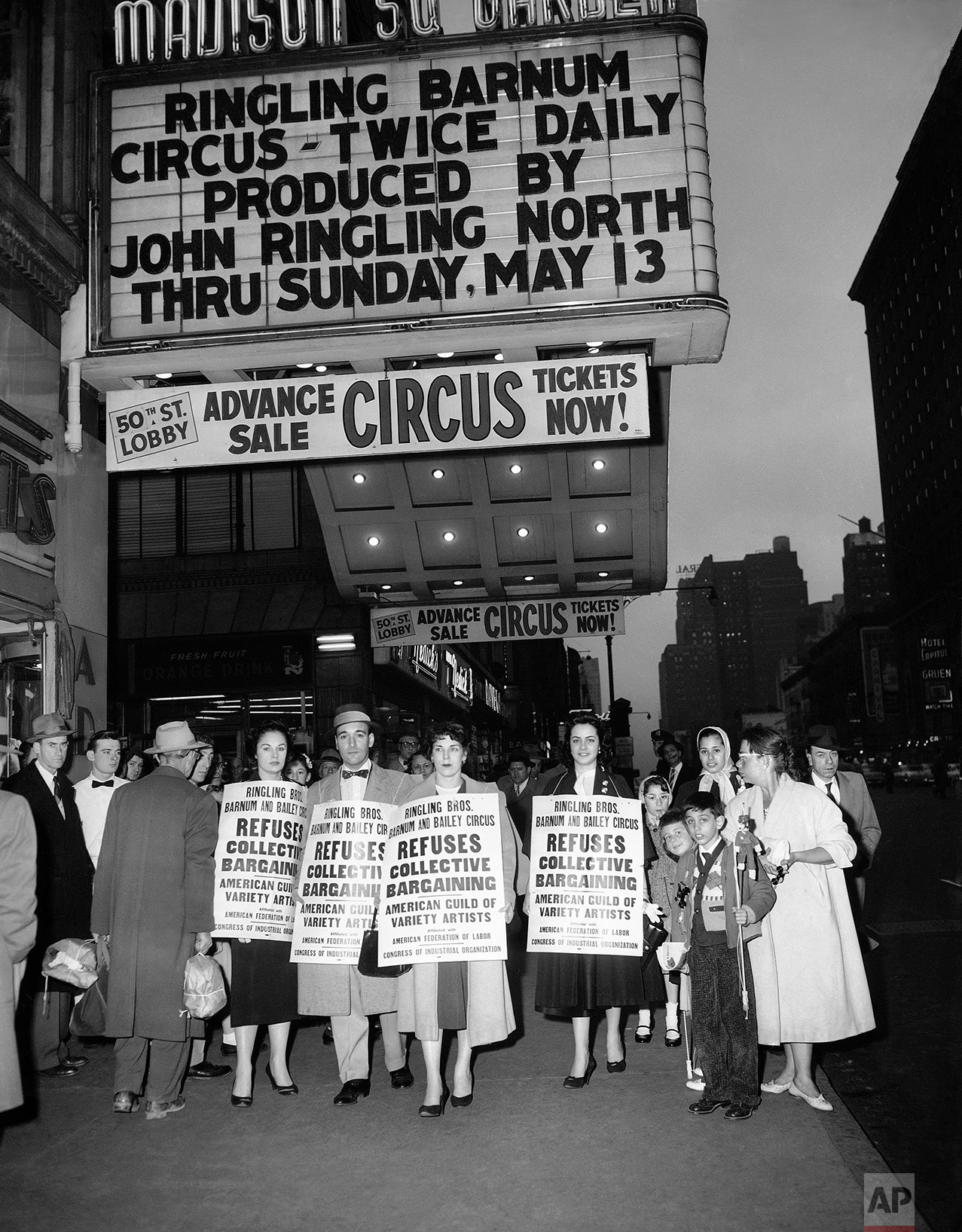
Labor Unions Performers Protest 1956
Pickets for AGVA (American Guild of Variety Artists) parade in front of the entrance to Madison Square Garden in New York, April 6, 1956 where the circus is in its first week. Picketing, banned on April 2 by restraining order issued by justice Thomas A. Aurelio, resumed after Supreme Court Justice Aron Steuer lifted the injunction. “The situation as regards AGVA reveals a labor dispute so... no injunction can issue in advance of a hearing, “ Judge Steuer ruled. (AP Photo/Tom Fitzsimmons)
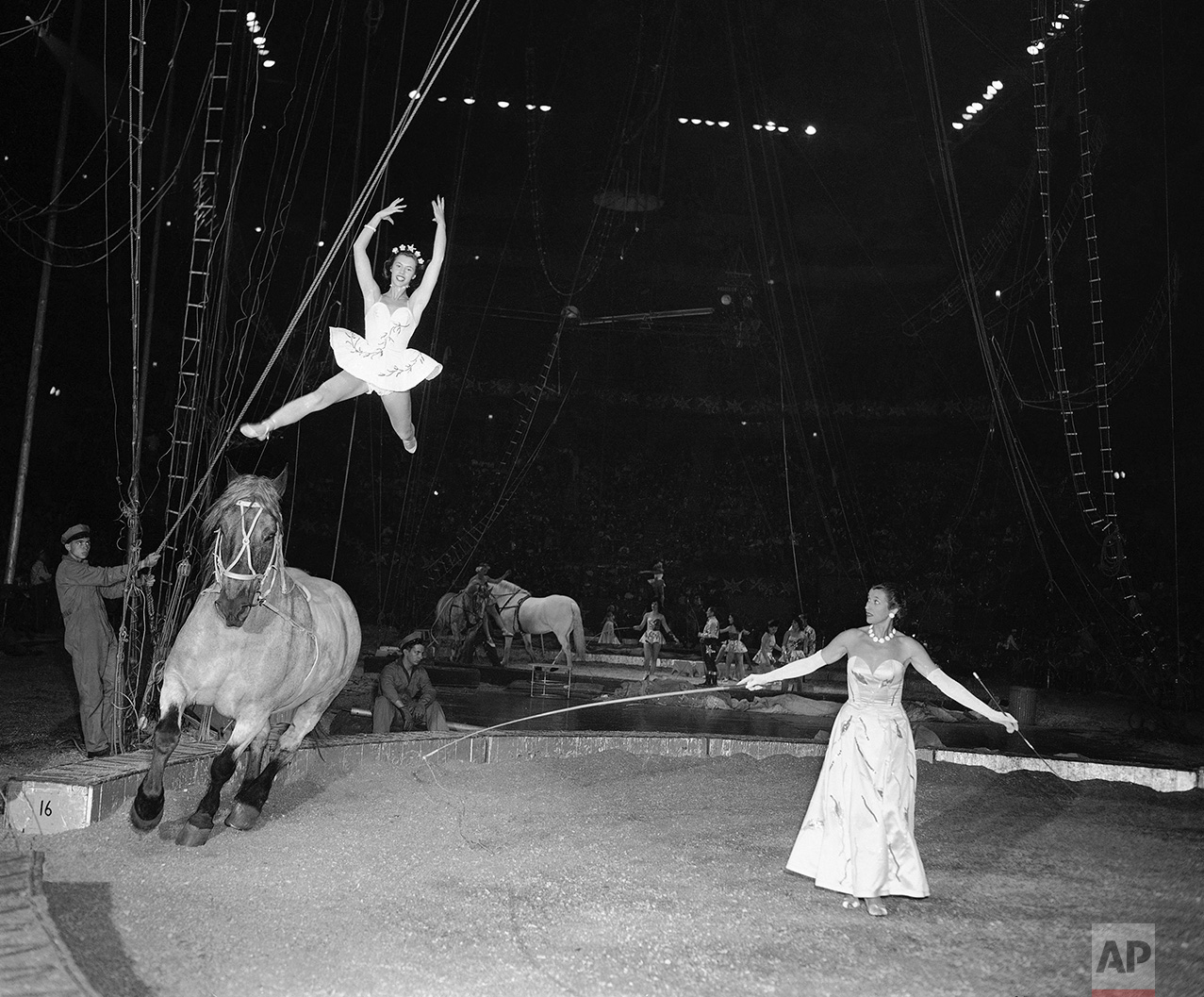
Circus Performer 1956
When 17-year-old Ilonka Karoly steps into the circus ring, spectators wonder how one of her age and size can do all the things she does at one performance. Ilonka is a ballerina with the Ringling Bros. and Barnum and Bailey circus, pictured May 12, 1956, in New York. (AP Photo/Robert Kradin)
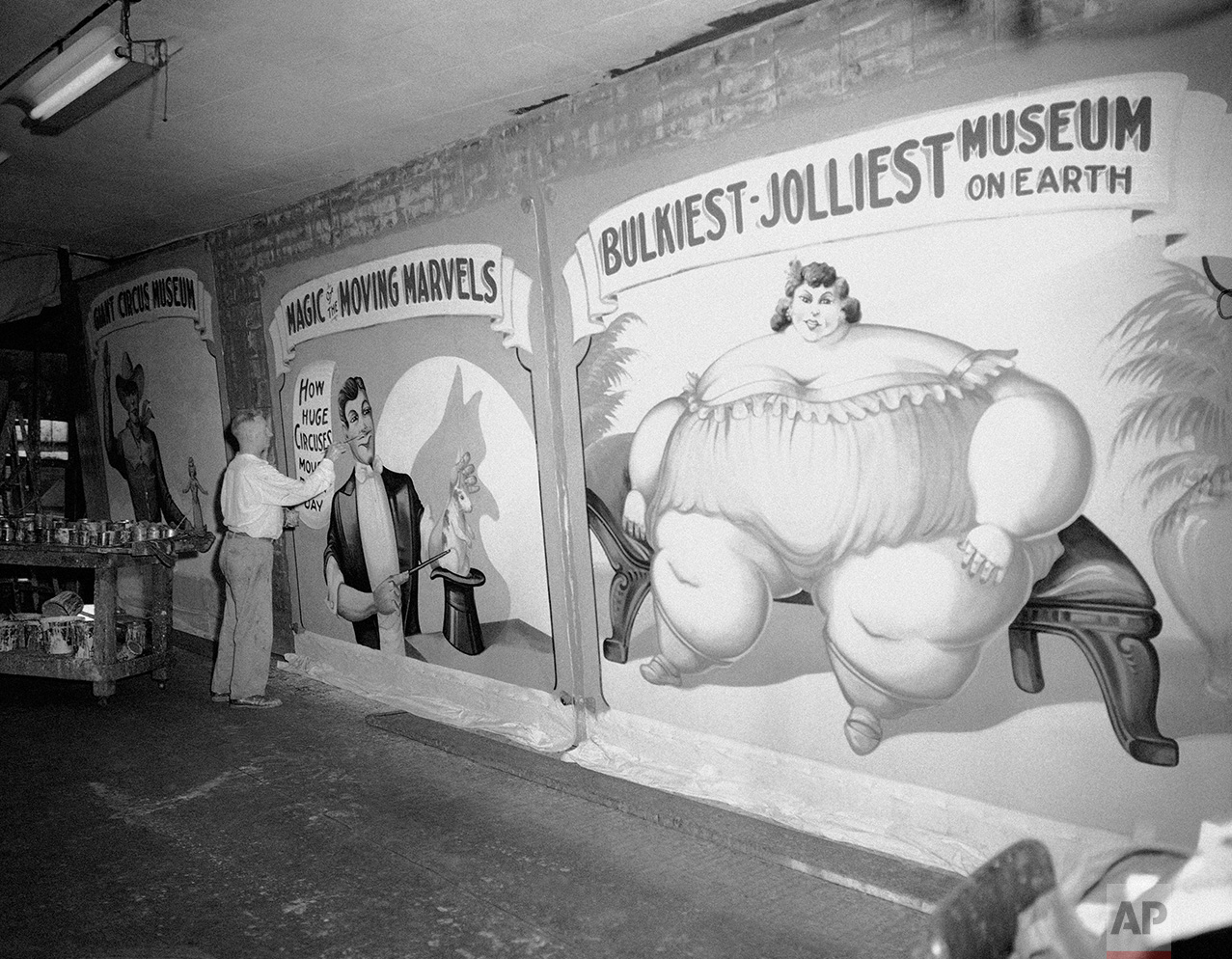
Circus Banner Artist 1959
Fred Johnson, 67, a banner artist of the old school, puts the final touches to huge banners on July 14, 1959 to be used in the new circus museum being installed at Baraboo, Wis. where the John Ringling Bros., circus began. Johnson still plys his art with a Chicago tent and awning firm. He began painting circus banners in 1909. (AP Photo/Edward Kitch)
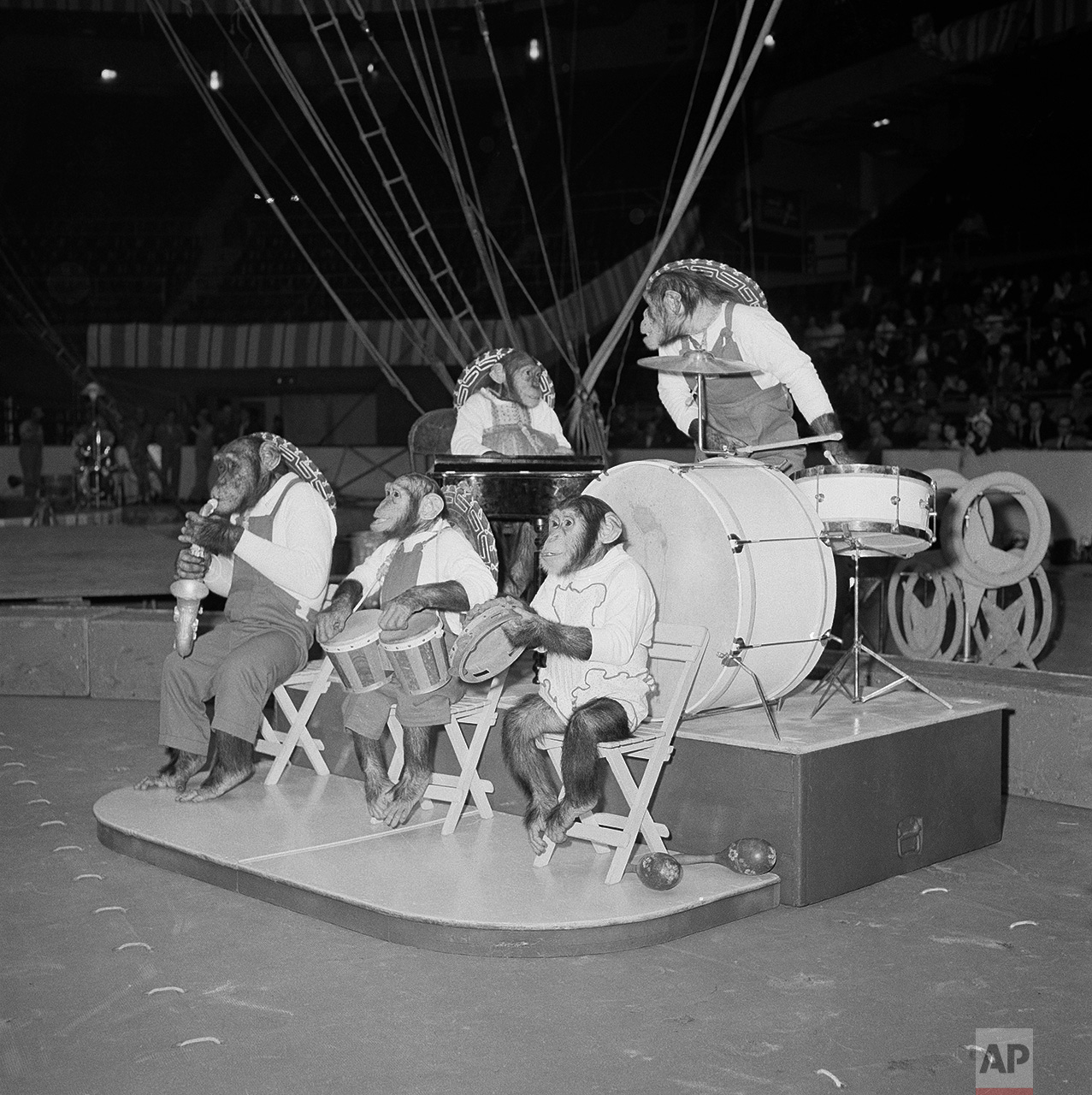
Band of Performing Chimpanzees 1959
Ringling Brothers, Barnum and Bailey Circus are going through their entertaining, amusing, and sometimes hair-raising stunts, as a band of performing chimpanzees sound off in Madison Square Garden in New York on March 30, 1959. (AP Photo/Harvey Lippman)

Clowns of Spring 1960
Clowns from the Ringling Brothers Barnum & Bailey Circus, Blinko, left, and Frankie Saluto, right, lend a hand in planting tulips and other flowers in the Channel Gardens of Rockefeller Center in New York, April 7, 1960. The Spring Bulb Show is the first floral displays to be placed in the gardens that are just off Fifth Avenue. (AP Photo/Hans Von Nolde)
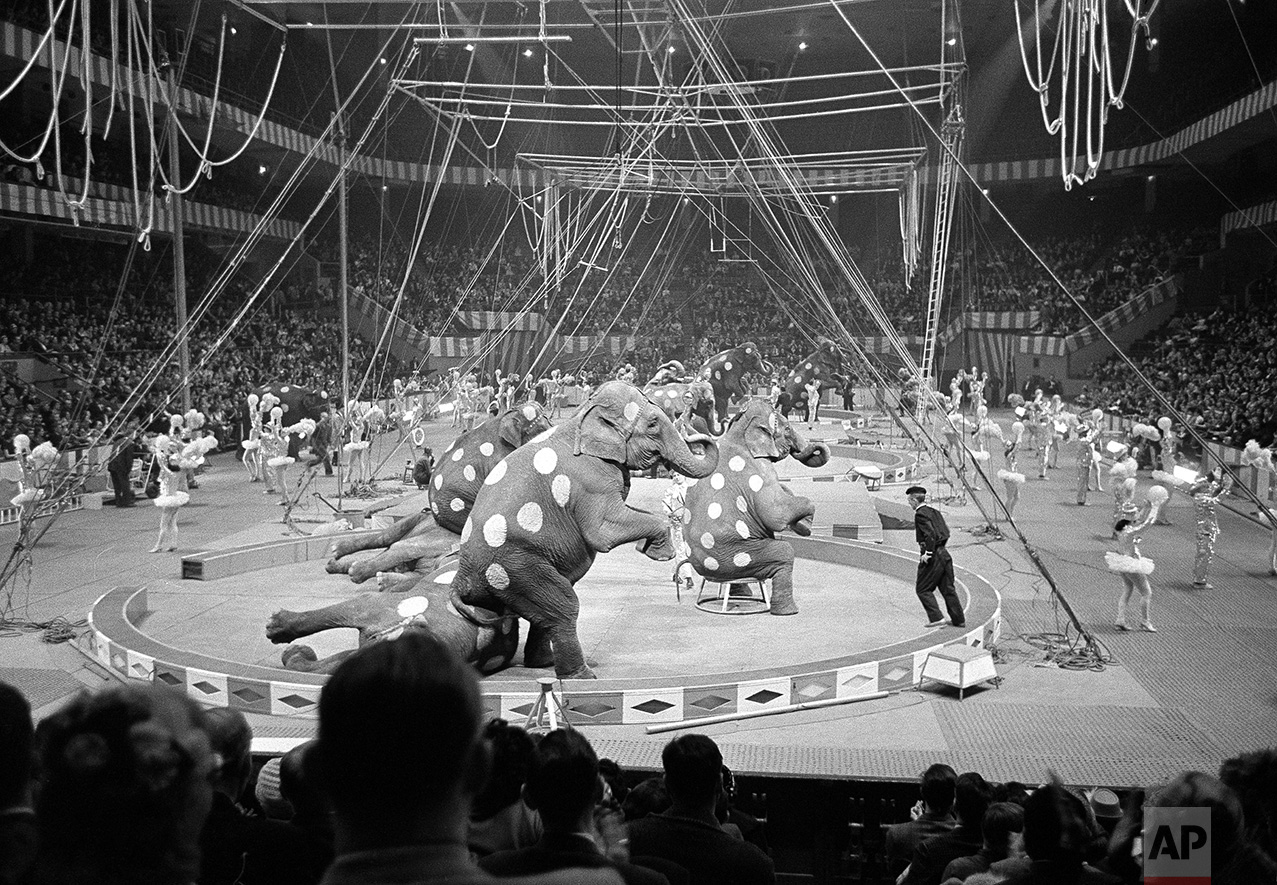
Elephants and Dancers 1961
Elephants and dancers go through their paces in opening stages of first night of the Ringling Brothers and Barnum and Bailey Circus at Madison Square Garden in New York on March 29, 1961. About 7,500 persons turned out for initial performance. (AP Photo/Marty Lederhandler)
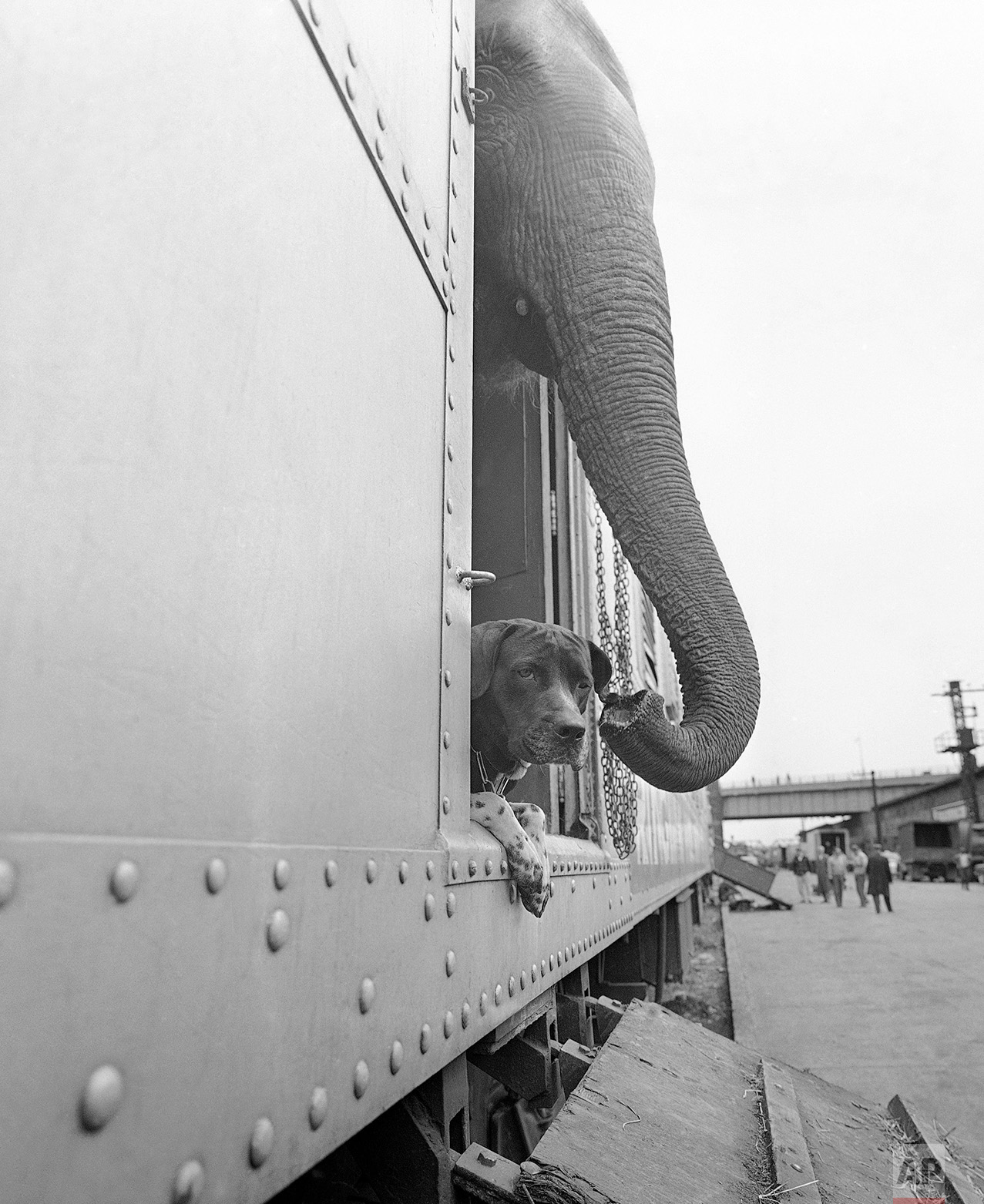
Unusual Combo 1963
An elephant and a dog peer apprehensively from a freight car before debarking at the Harlem River freight yards in New York City, April 1, 1963. The animals were on the Ringling Brothers and Barnum and Bailey Circus train arriving in New York for the opening of the Circus at Madison Square Garden on April 3. (AP Photo/Goldberg)
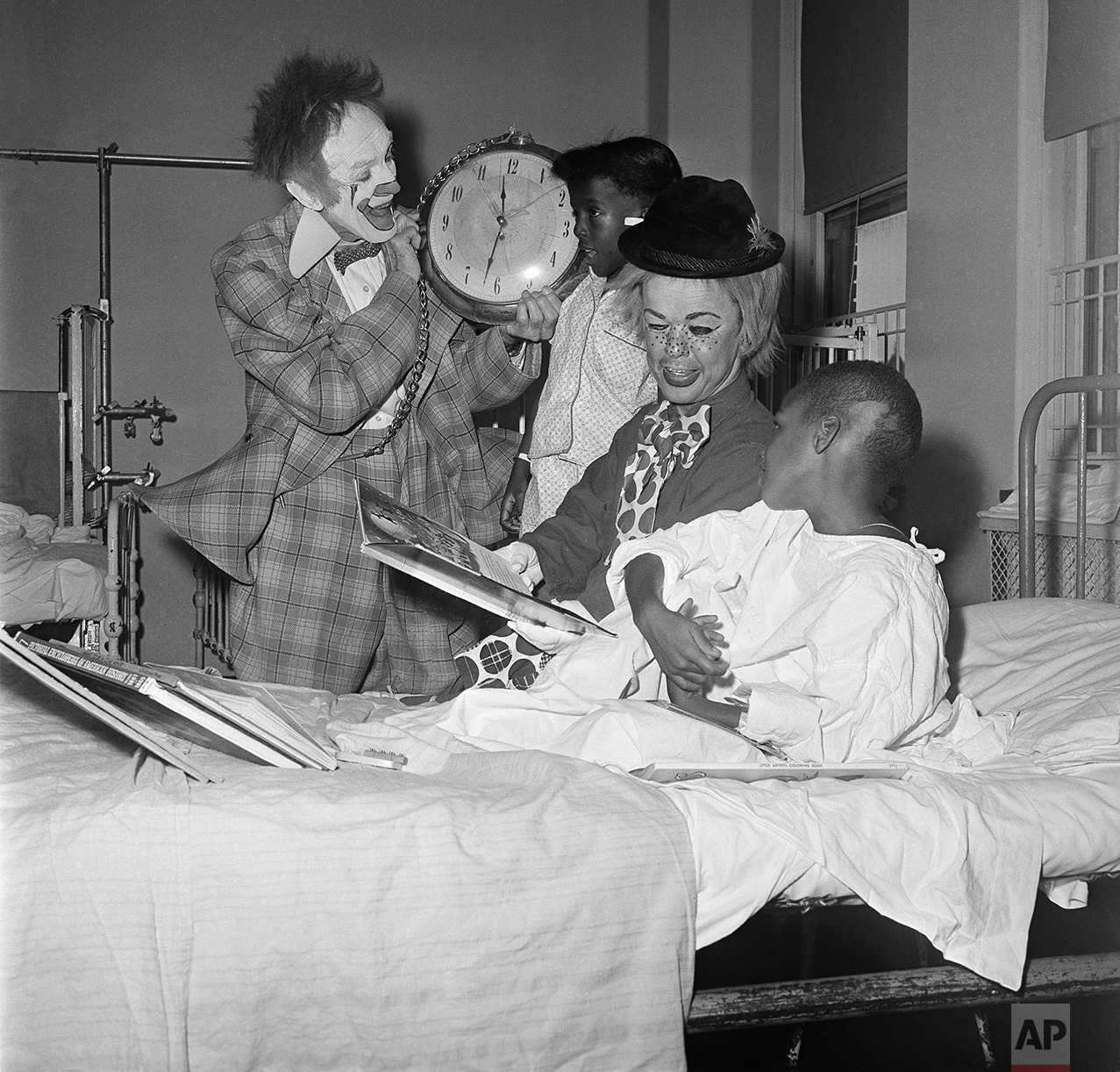
Clowns Children's Hospital 1966
Clowns at the children’s party thrown by Chicago Mayor Richard Daley at the Cook County Hospital in Chicago on Oct. 10, 1966. Some 35 clowns of the Ringling Brothers and Barnum and Bailey circus entertained the shut-in kids at the hospital. (AP Photo/Paul Cannon)
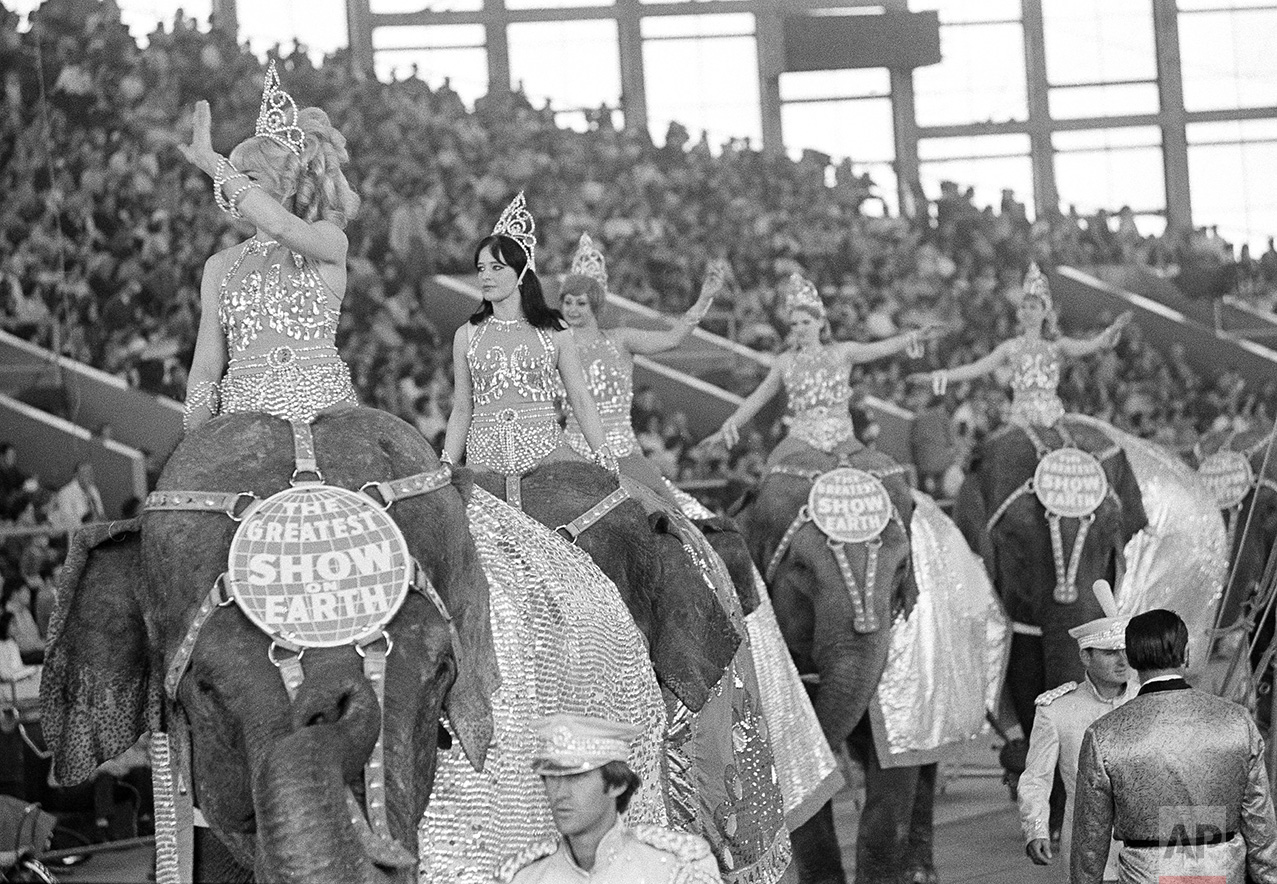
Elephants Parading 1970
The Ringling Bros. and Barnum & Bailey Circus presents its one-hundredth edition with a troupe of elephants parading in New York on March 6, 1970. (AP Photo/Dave Pickoff)

Clown Birthday 1973
Lou Jacobs, center, whose face has appeared on Ringling Brothers and Barnum and Bailey circus posters for the past 30 years, poses with his wife Jean, holding his dog Knucklehead, and daughters Dolly and Lou Anne, left and right, both circus show girls, before the circus’ performance, May 16, 1973. Jacobs, who had has been making smiles in the circus for 50 years is also celebrating his 70th birthday at the main arena of Madison Square Garden in New York. Dolly Jacobs is 16, Lou Anne, 18. (AP Photo/Anthony Camerano)
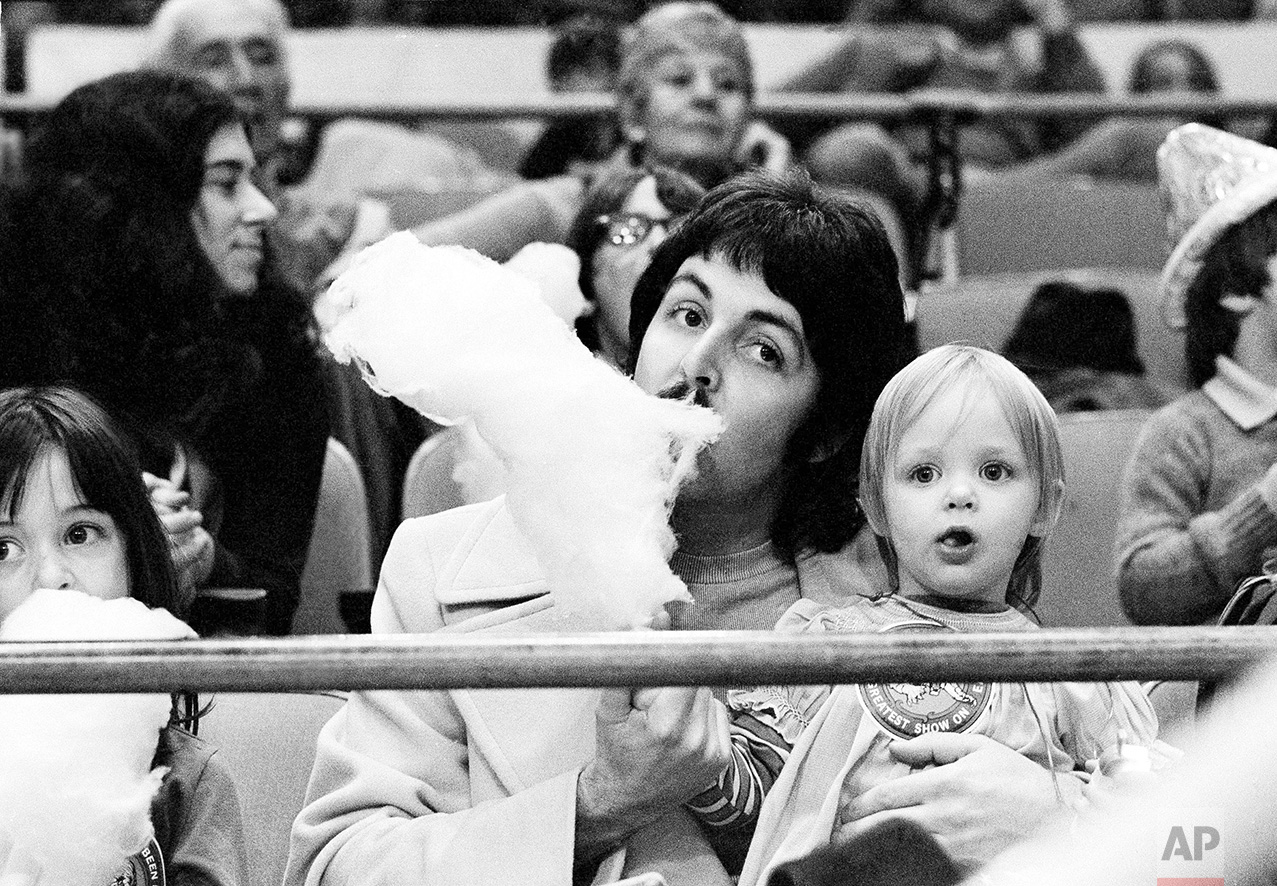
McCartneys Circus 1974
Former Beatle Paul McCartney samples his young daughter Stella's cotton candy as the two sit on the sidelines at New York's Madison Square Garden, March 30, 1974, watching the Ringling Bros. & Barnum and Bailey Circus. (AP Photo/Suzanne Vlamis)
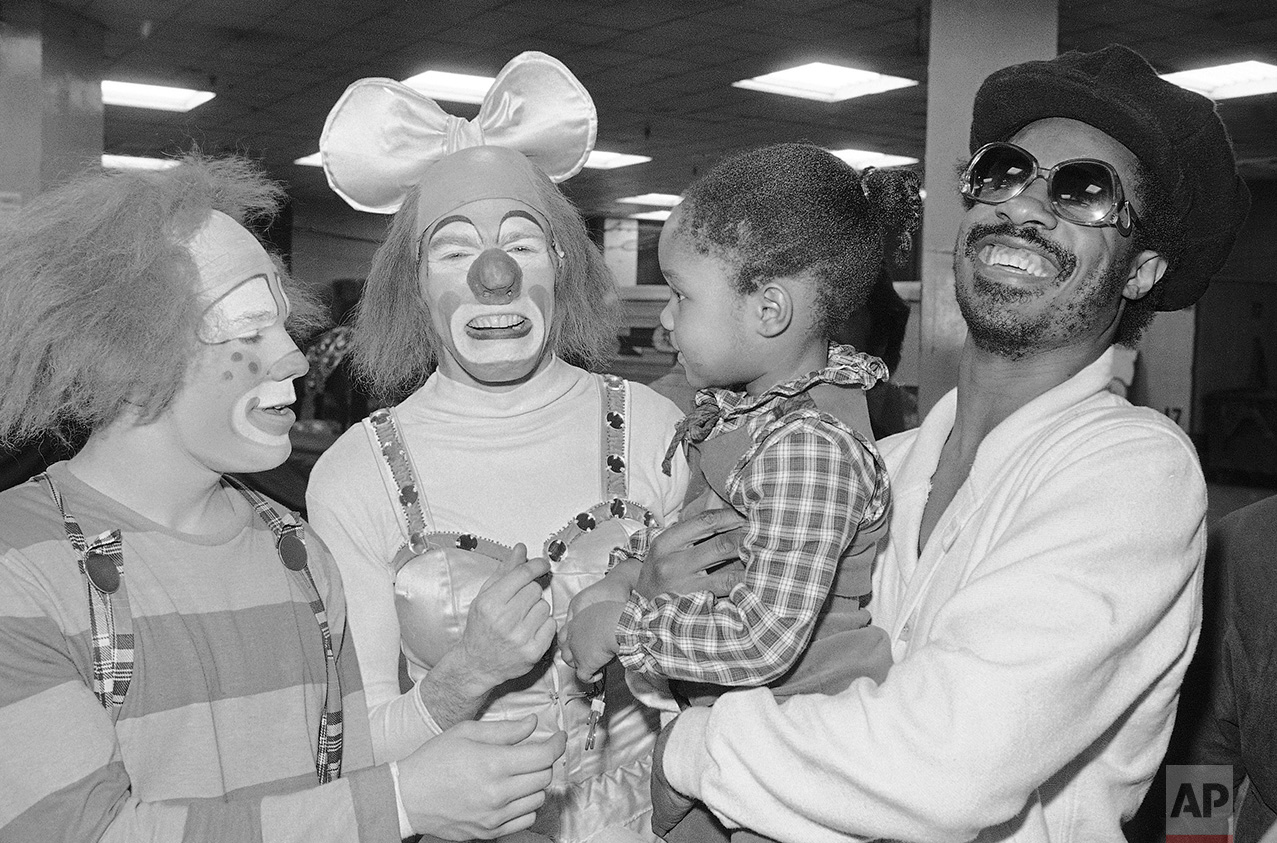
Stevie Wonder Circus Clowns 1978
Stevie Wonder, right, with daughter Ayesha Clowning with clowns backstage at the Ringling Bros., Barnum & Bailey circus during the intermission on Monday, March 27, 1978 at New York's Madison square garden. (AP Photo/Richard Drew)
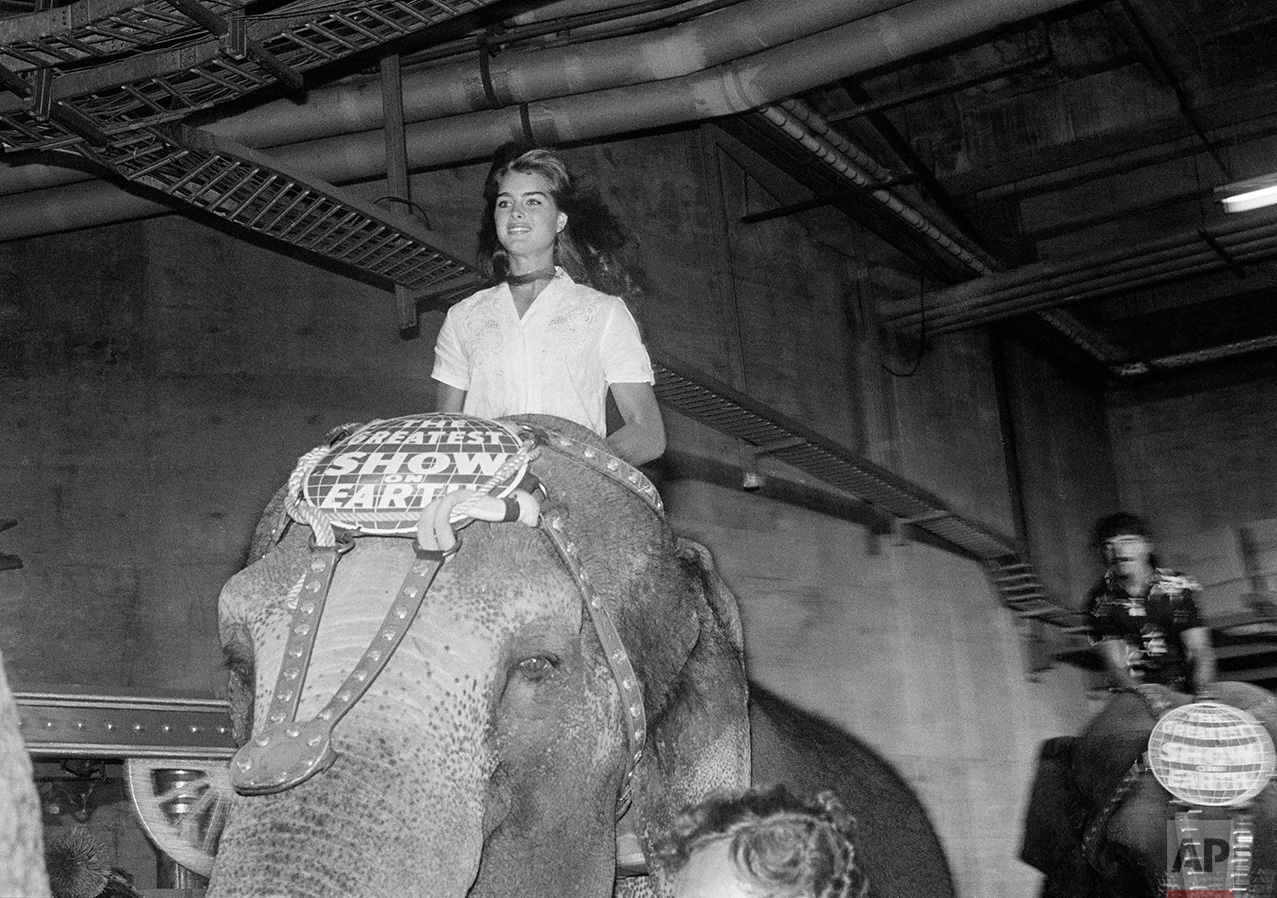
Brooke Shields Rides Elephant 1982
Actress and model Brooke Shield sits tall atop an elephant as she participates in the Galaxy of Stars Gala for the benefit of Vista Del Mare Child Care Services, during the opening of the Ringling Brothers and Barnum and Bailey Circus on July 21, 1982 in Los Angeles. (AP Photo/ Nick Ut)

Alexander Calder Clowns 1982
Clowns from Ringling Bros. and Barnum and Baily Circus admire artist Alexander Calder’s sculpture titled “The Circus” at New York’s Whitney Museum of American Art, April 16, 1982. The museum has begun a fund drive to raise $1.25 million in six weeks to keep the sculpture that the artist’s estate plans to sell. Producers of Ringling Bros. and Barnum and Baily Circus have agreed to help with the campaign. (AP Photo/David Pickoff)

Send In The Clowns 1984
Kevin Thompson, celebrating his fourth year in Ringling Bros. Barnum and Bailey's famed Clown Alley, watches as 9-year-old Jonathon Young tries his hand at clowning during a visit by the circus troupe to Temple Beth Solomon of the Deaf in Arleta, California, Sept. 14, 1984. (AP Photo/Liu Heung Shing)
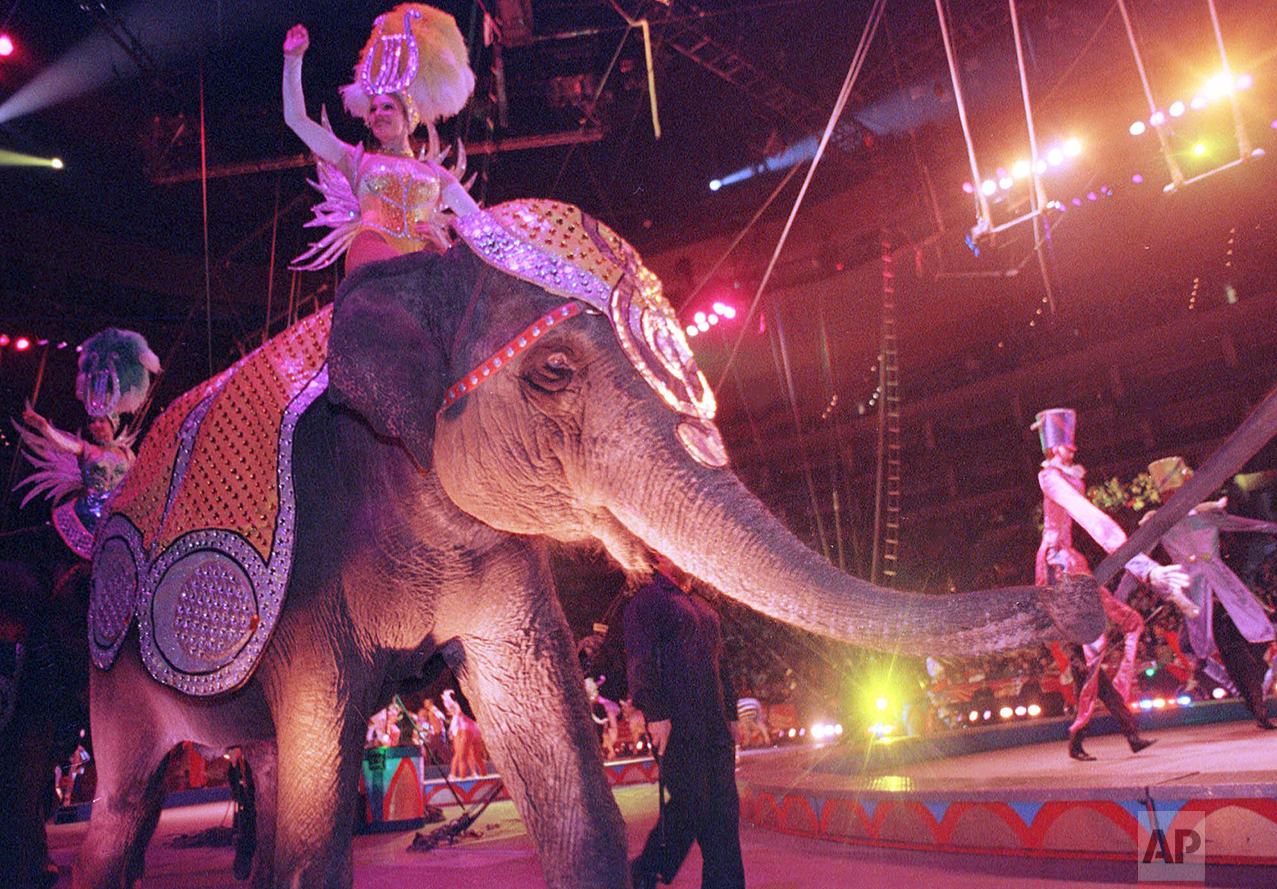
Opening Parade 1998
Elephants march around the Fleet Center floor during the opening parade of the Ringling Bros. and Barnum & Bailey circus Wednesday, Oct. 14, 1998. (AP Photo/Patricia McDonnell)
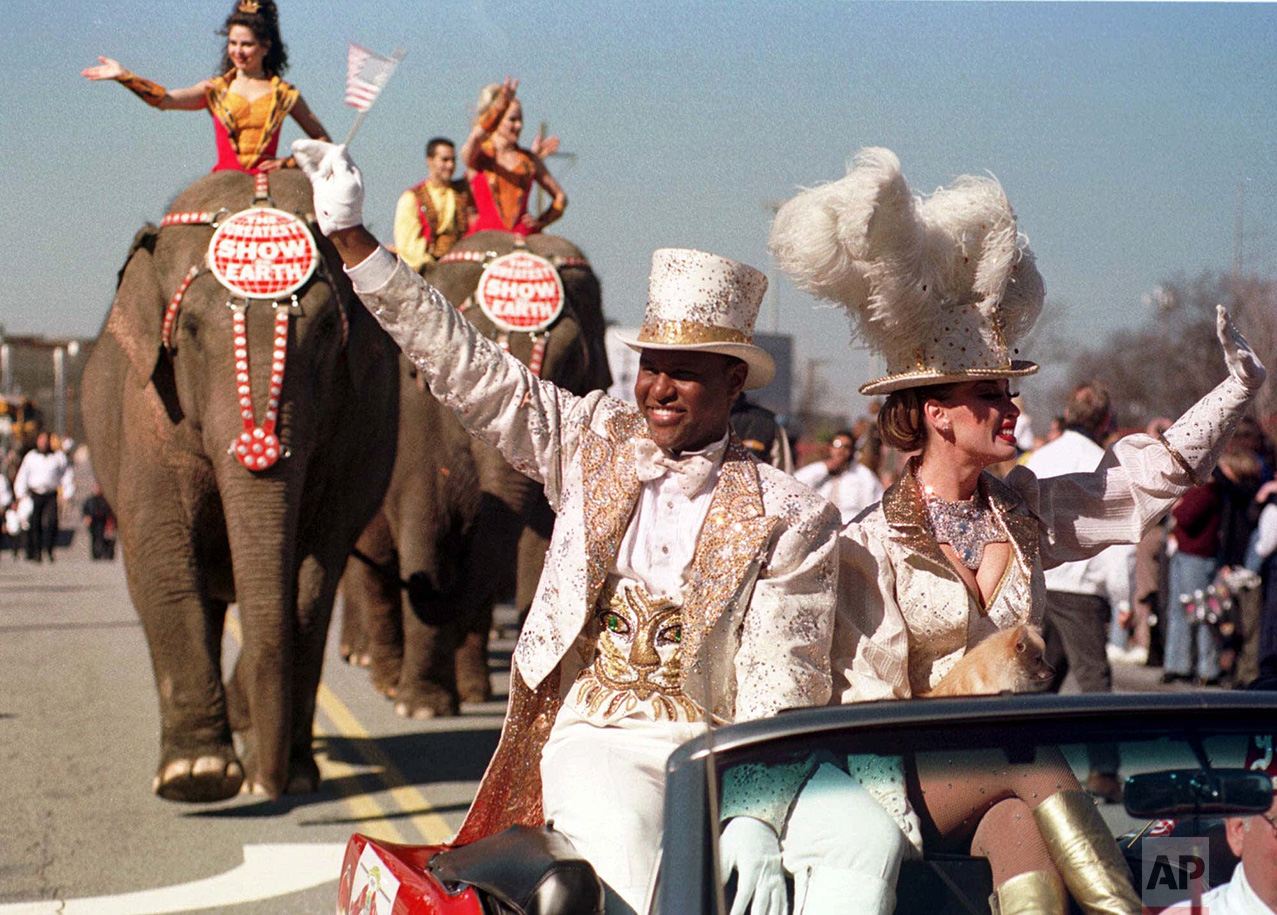
Atlanta Circus Parade 2000
Ringmaster for Ringling Bros. and Barnum & Bailey circus Jonathan Lee Iverson and Catherine Hanneford lead a parade through downtown Atlanta on Monday, Feb. 21, 2000. This marks the first return for the circus to Atlanta in some 80 years. (AP Photo/Alan Mothner
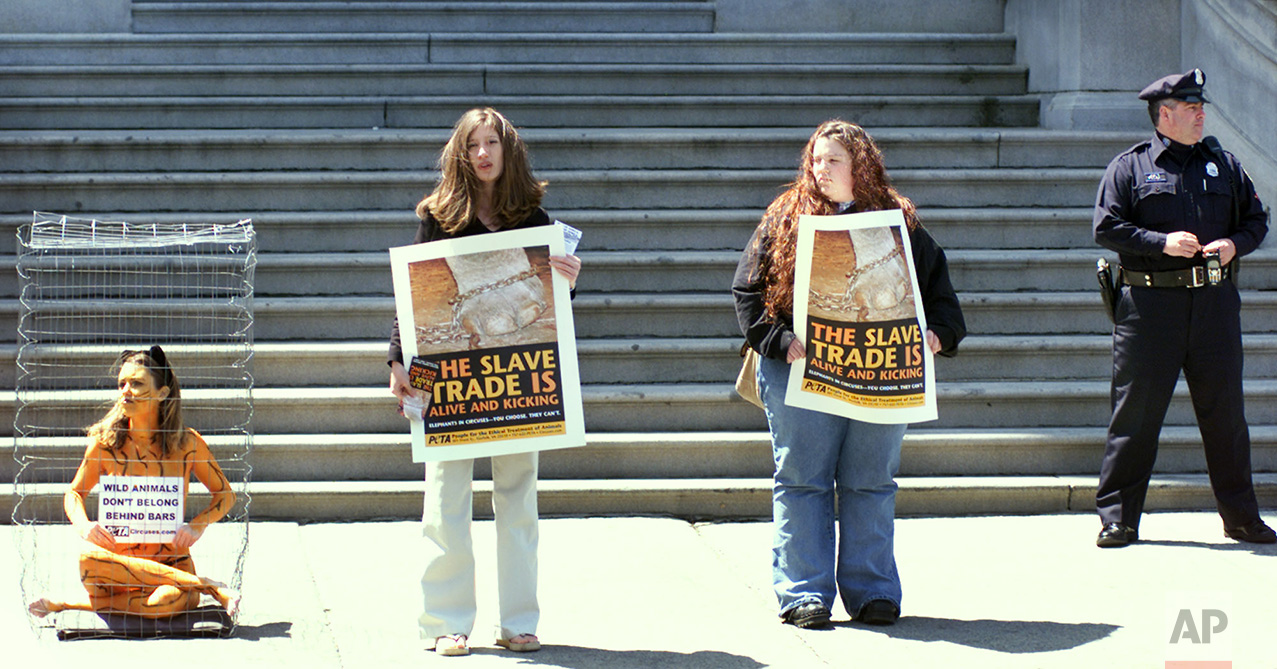
PETA Protests Circus 2002
Tia Hrusa, 23, of Colchester, Conn., a member of People for the Ethical Treatment of Animals, sits in a cage painted as a circus tiger, as PETA spokesperson Brandi Valladolid, second from left, and an unidentified PETA volunteer hold signs while a Providence, R.I., police officer looks on during a protest outside Providence City Hall Thursday, April 25, 2002. PETA was protesting the upcoming visit of Ringling Brothers and Barnum & Bailey Circus to Providence. (AP Photo/Victoria Arocho)
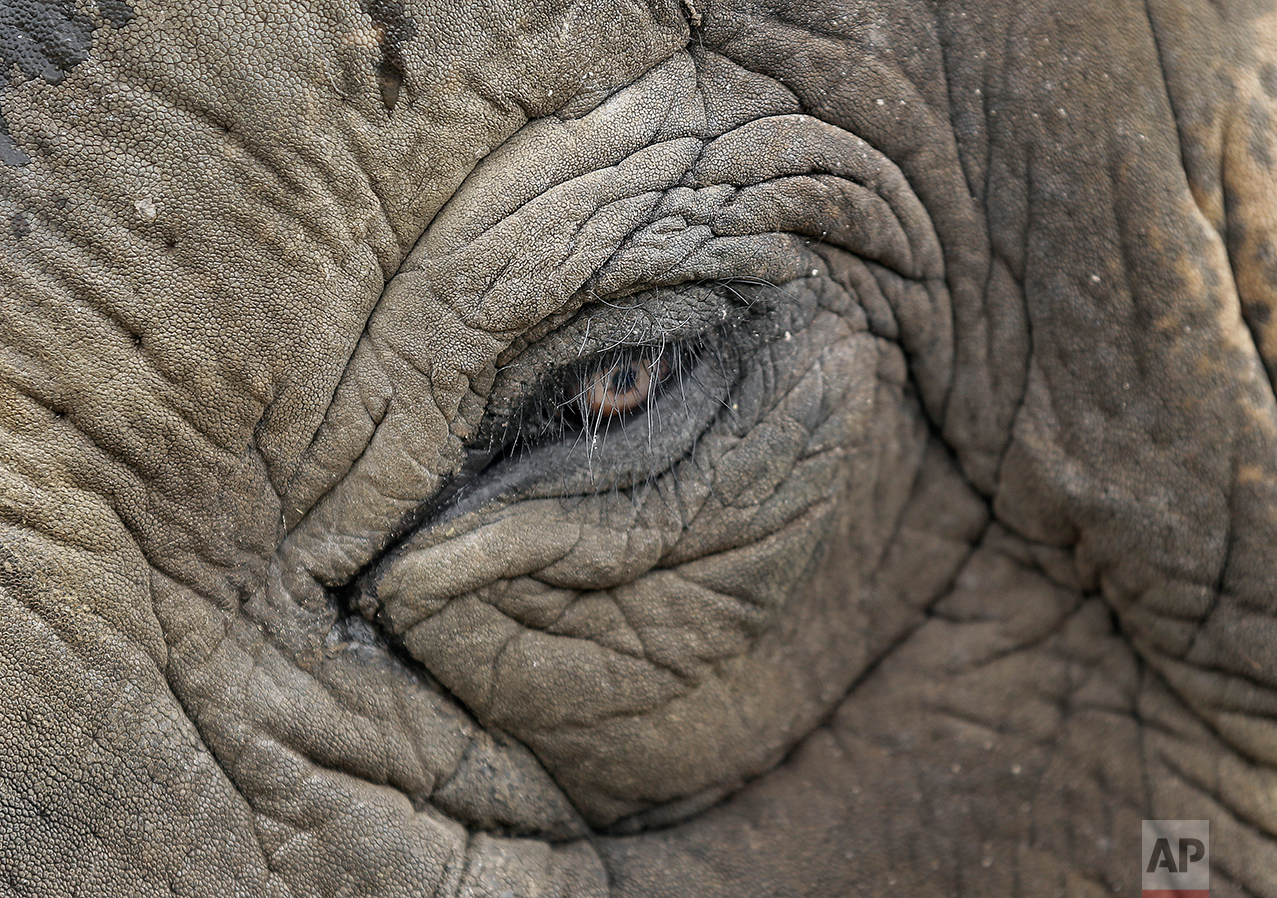
Circus Elephants Phase Out 2015
In this Tuesday, Feb. 24, 2015 photo, elephant Angelica is seen at the Ringling Bros. and Barnum & Bailey Center for Elephant Conservation, in Polk City, Fla. The Ringling Bros. and Barnum & Bailey Circus said it will phase out its iconic elephant acts by 2018. (AP Photo/Chris O'Meara)
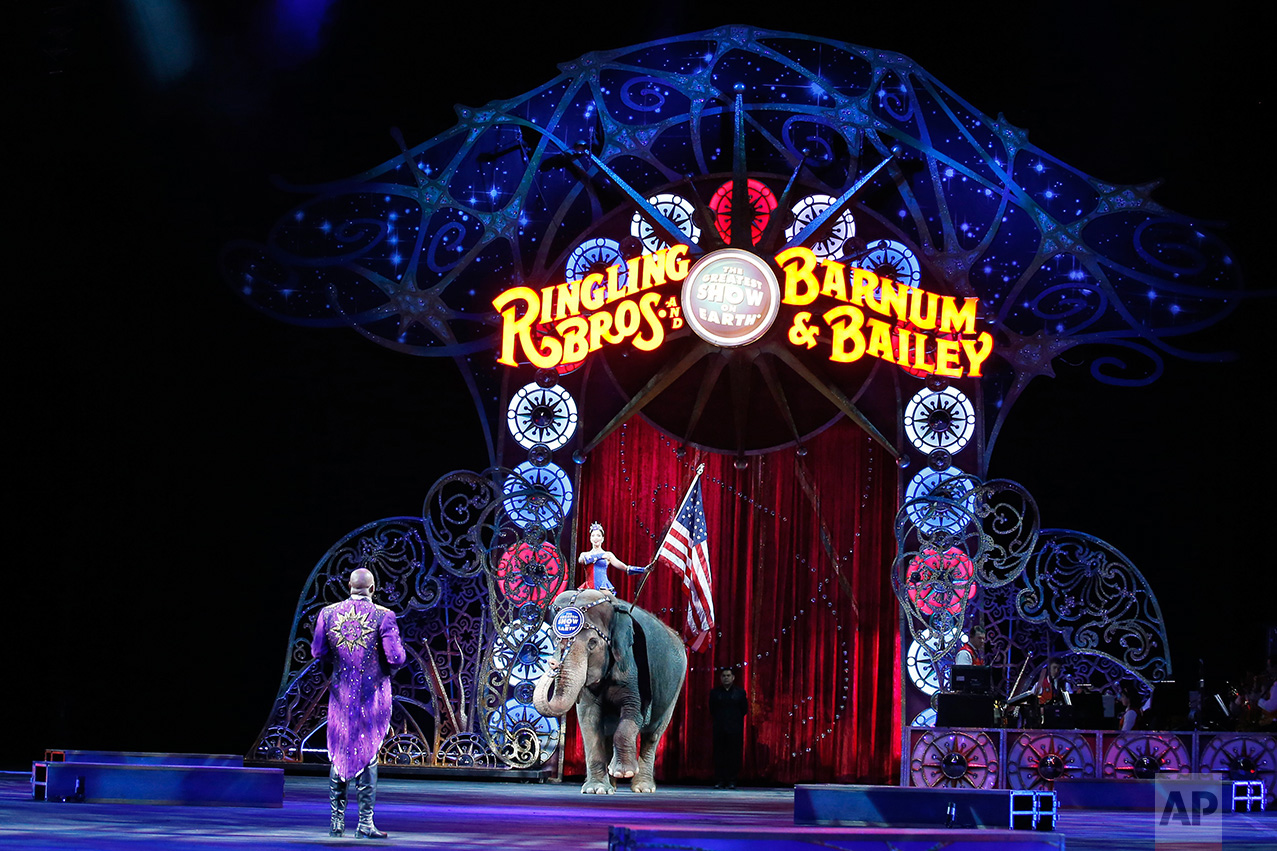
Ringling Bros Circus Elephants 2015
An elephant stands during the National Anthem during a performance of the Ringling Bros. and Barnum & Bailey Circus, Thursday, March 19, 2015 in Washington. It was recently announced elephants would be eliminated from its circus performances by 2018. (AP Photo/Alex Brandon)
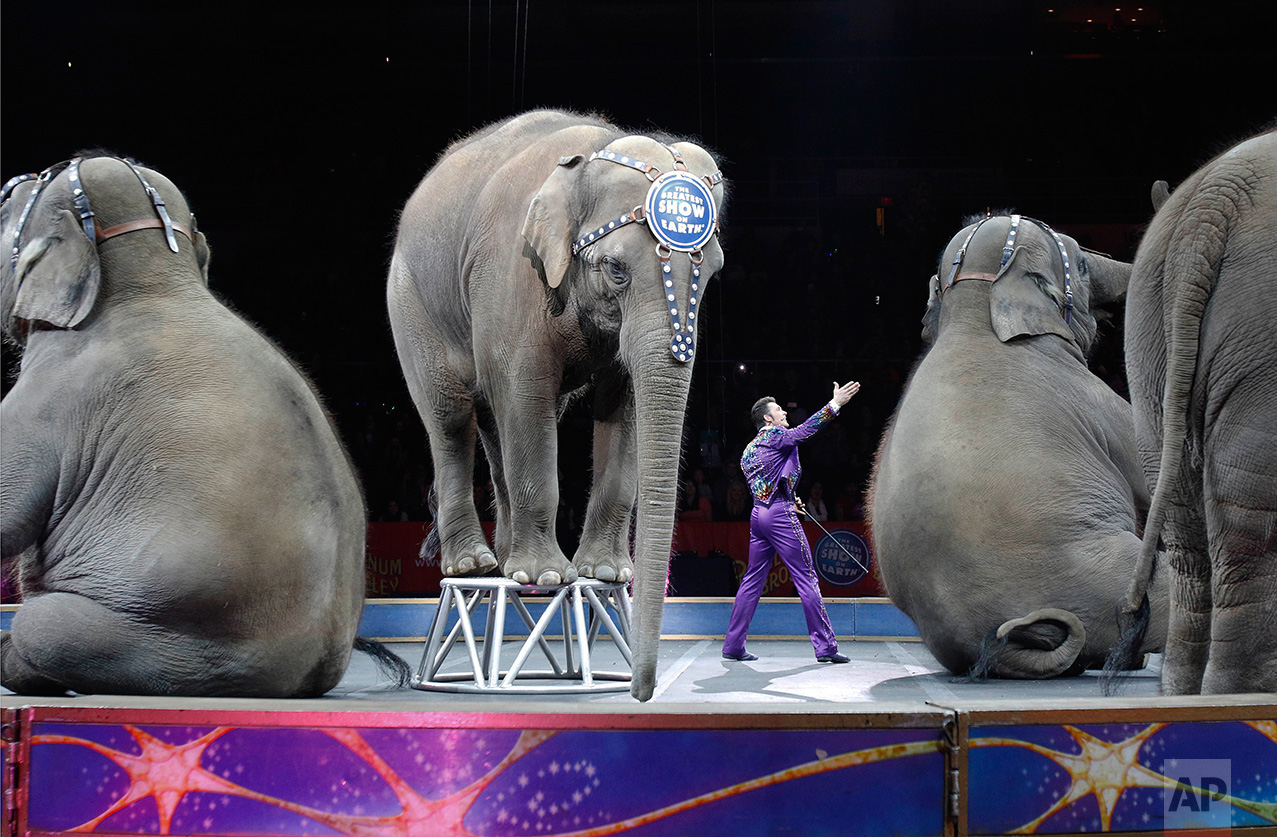
Last Circus Elephants 2016
Asian elephants perform for the final time in the Ringling Bros. and Barnum & Bailey Circus Sunday, May 1, 2016, in Providence, R.I. The circus closes its own chapter on a controversial practice that has entertained audiences since circuses began in America two centuries ago. The animals will live at the Ringling Bros. 200-acre Center for Elephant Conservation in Florida. (AP Photo/Bill Sikes)
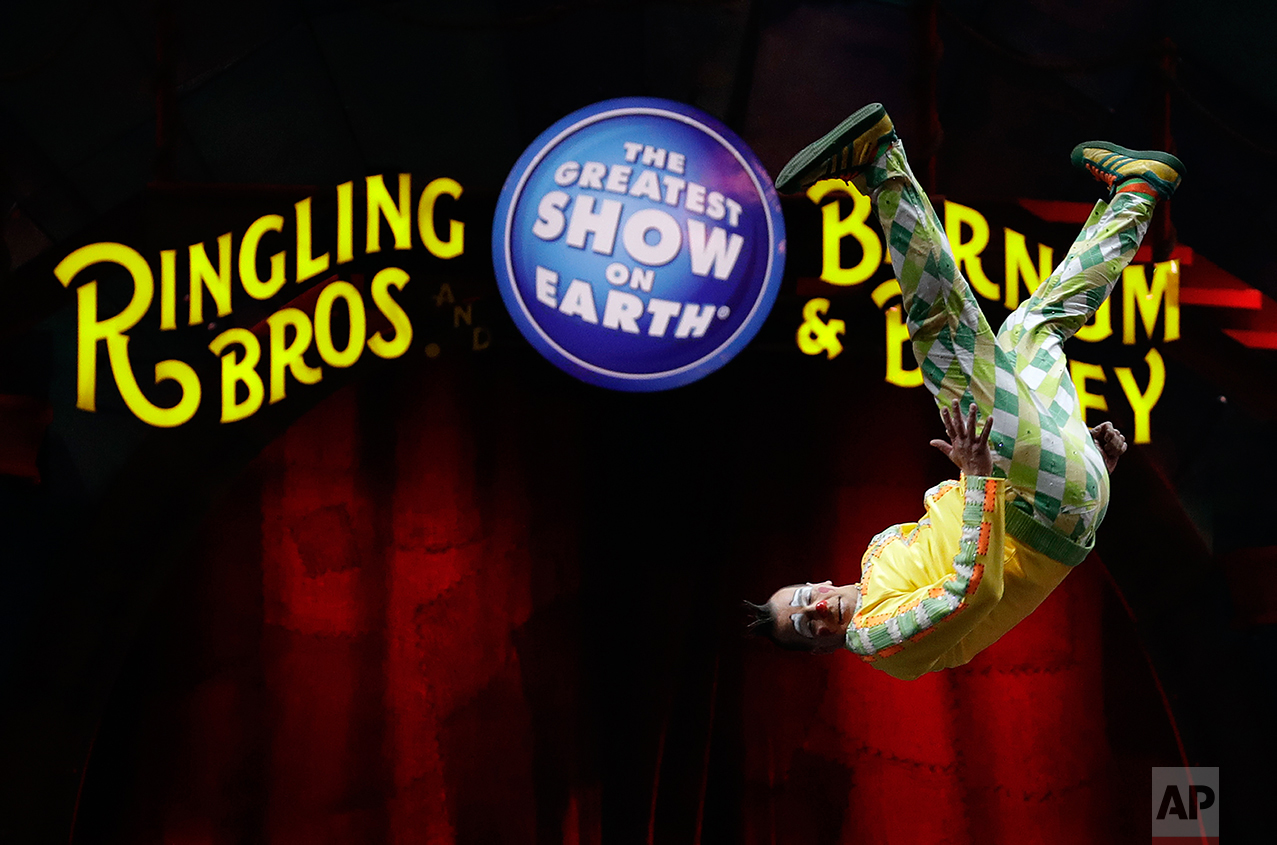
Ringling Bros Closing 2017
A Ringling Bros. and Barnum & Bailey clown does a somersault during a performance Saturday, Jan. 14, 2017, in Orlando, Fla. The Ringling Bros. and Barnum & Bailey Circus will end the "The Greatest Show on Earth" in May, following a 146-year run of performances. Kenneth Feld, the chairman and CEO of Feld Entertainment, which owns the circus, told The Associated Press, declining attendance combined with high operating costs are among the reasons for closing. (AP Photo/Chris O'Meara)
Text from the AP news story, Ringling's evolution, from freak shows to the big top.
Follow AP photographers on Twitter
See these photos on APImages
Written content on this site is not created by the editorial department of AP, unless otherwise noted.
Visual artist and Journalist


